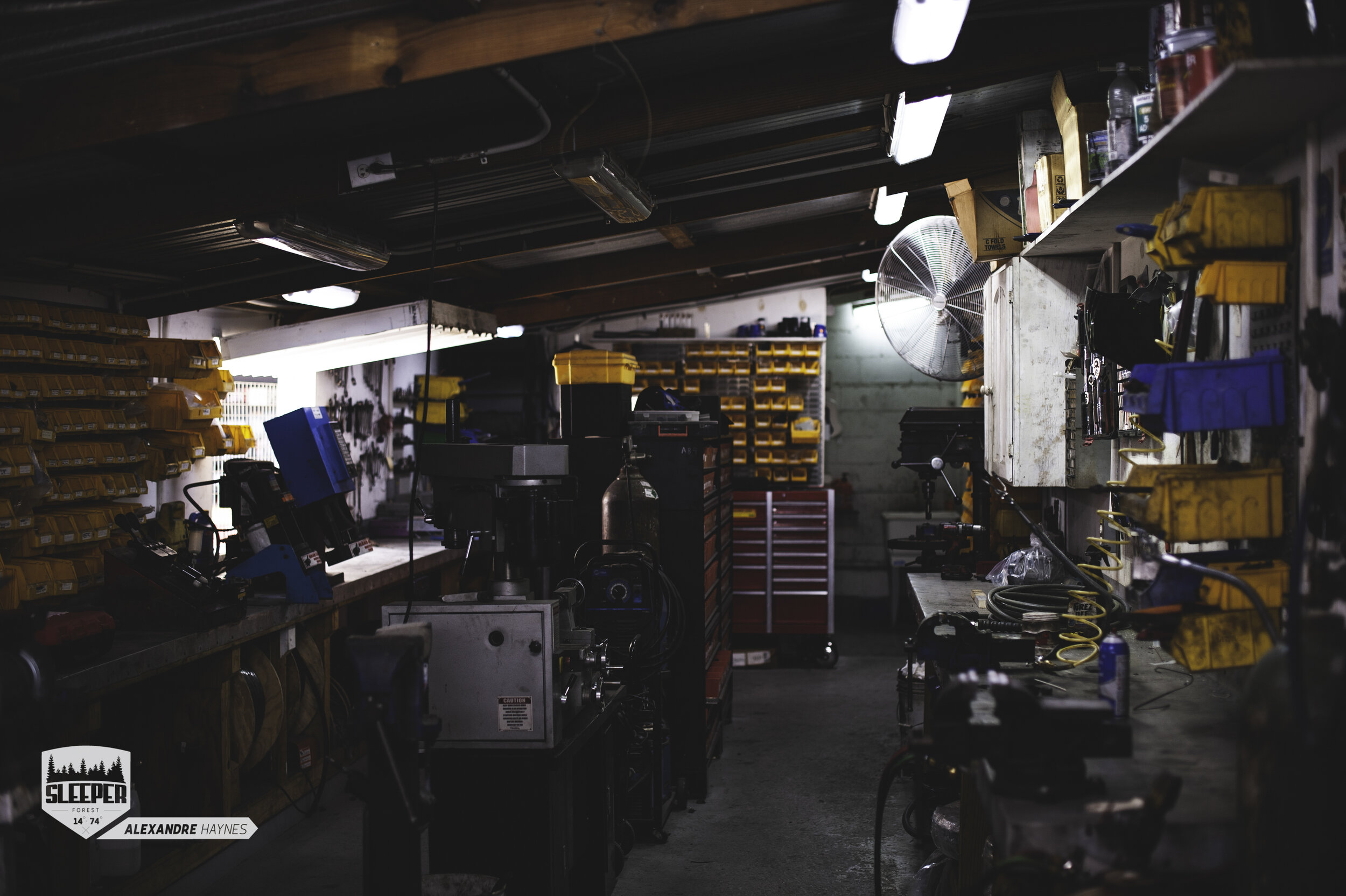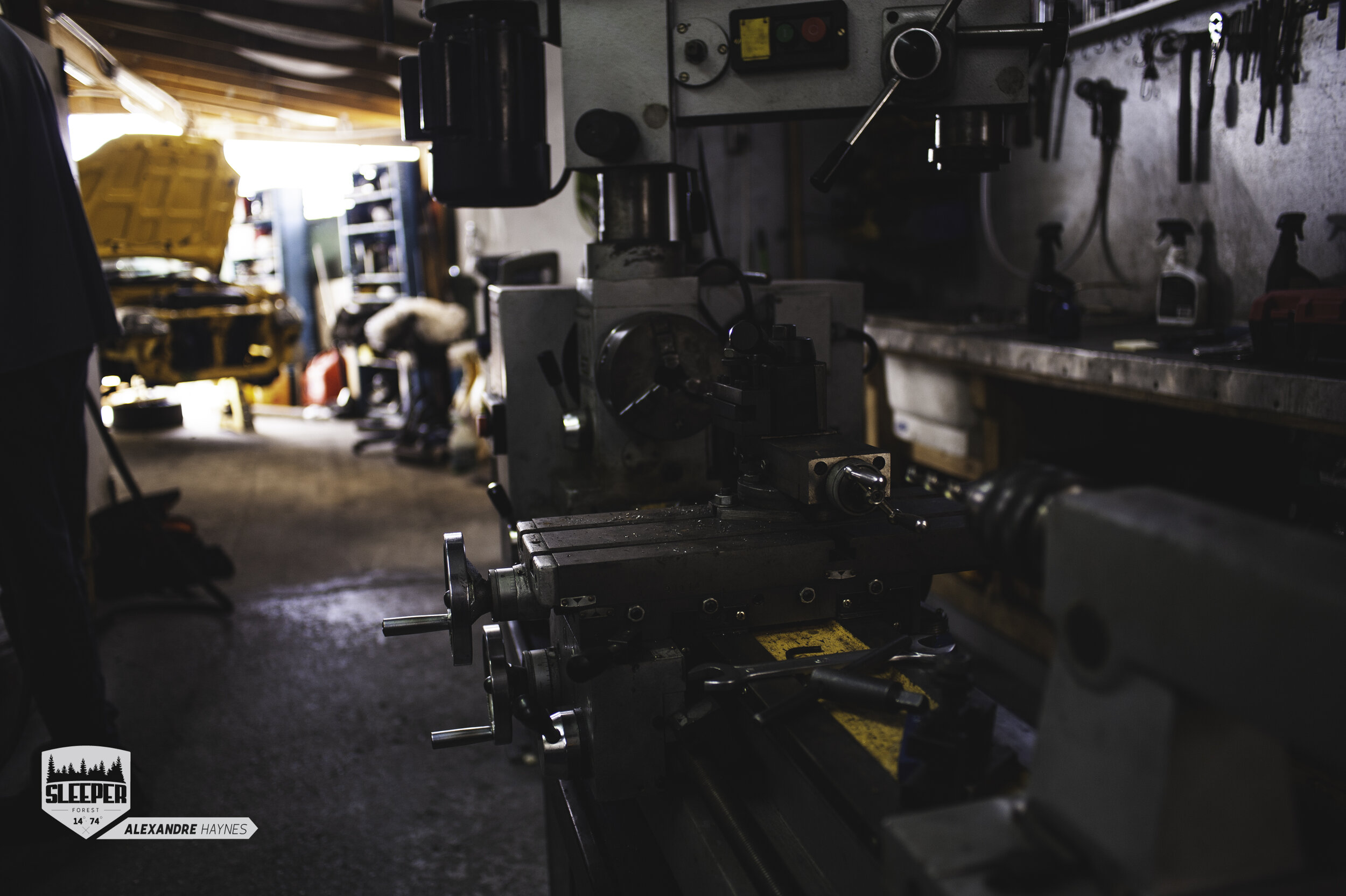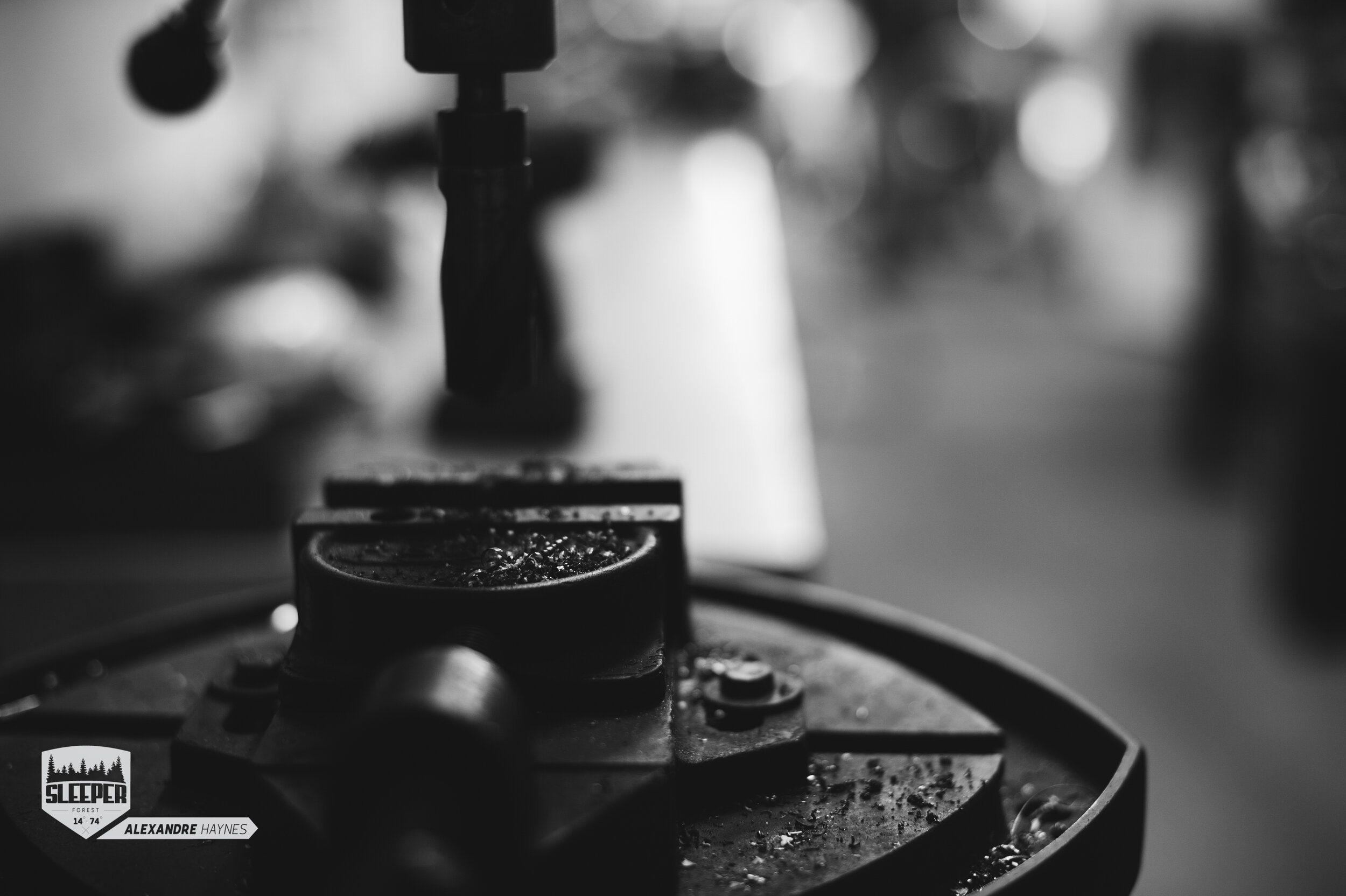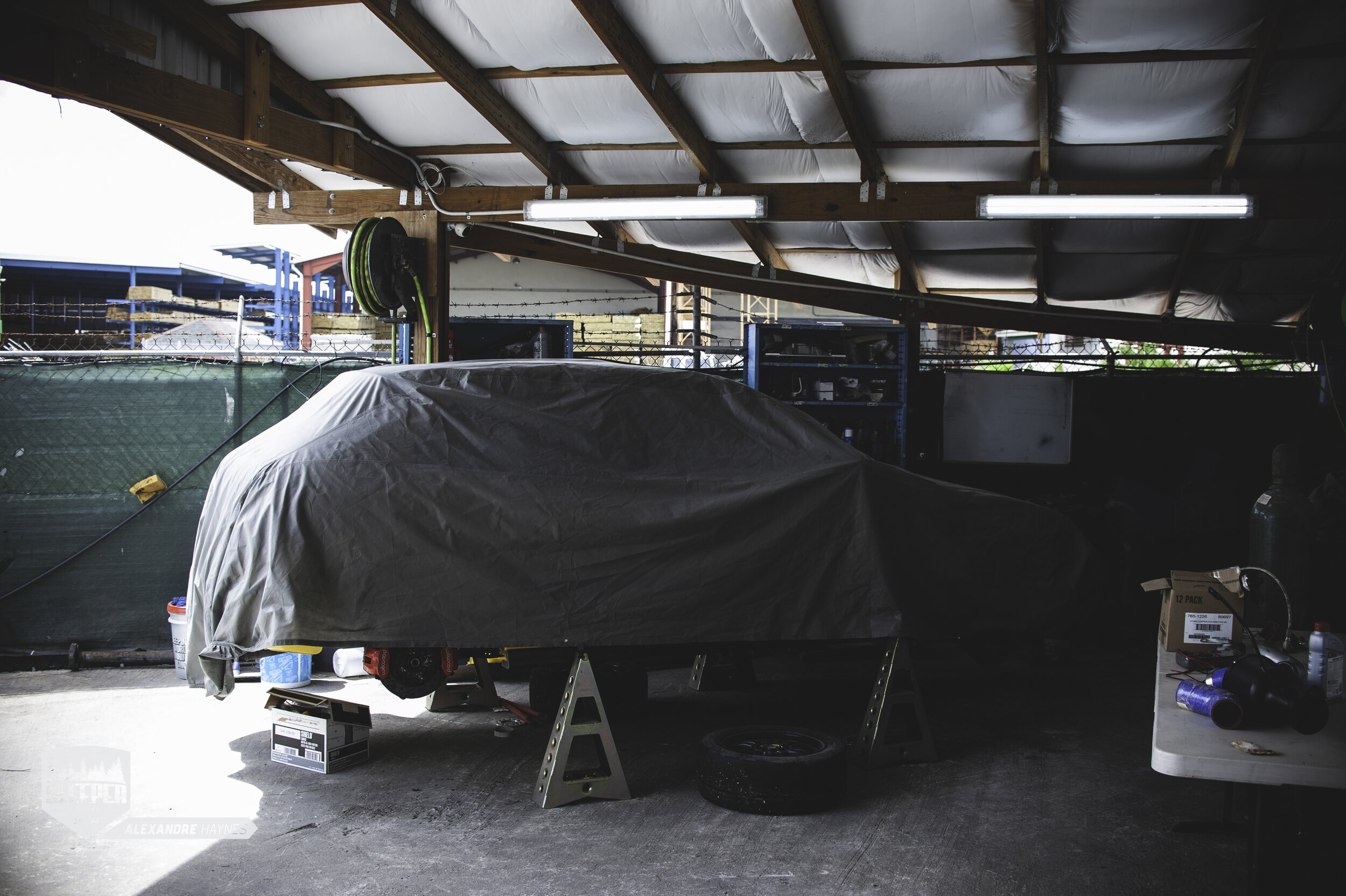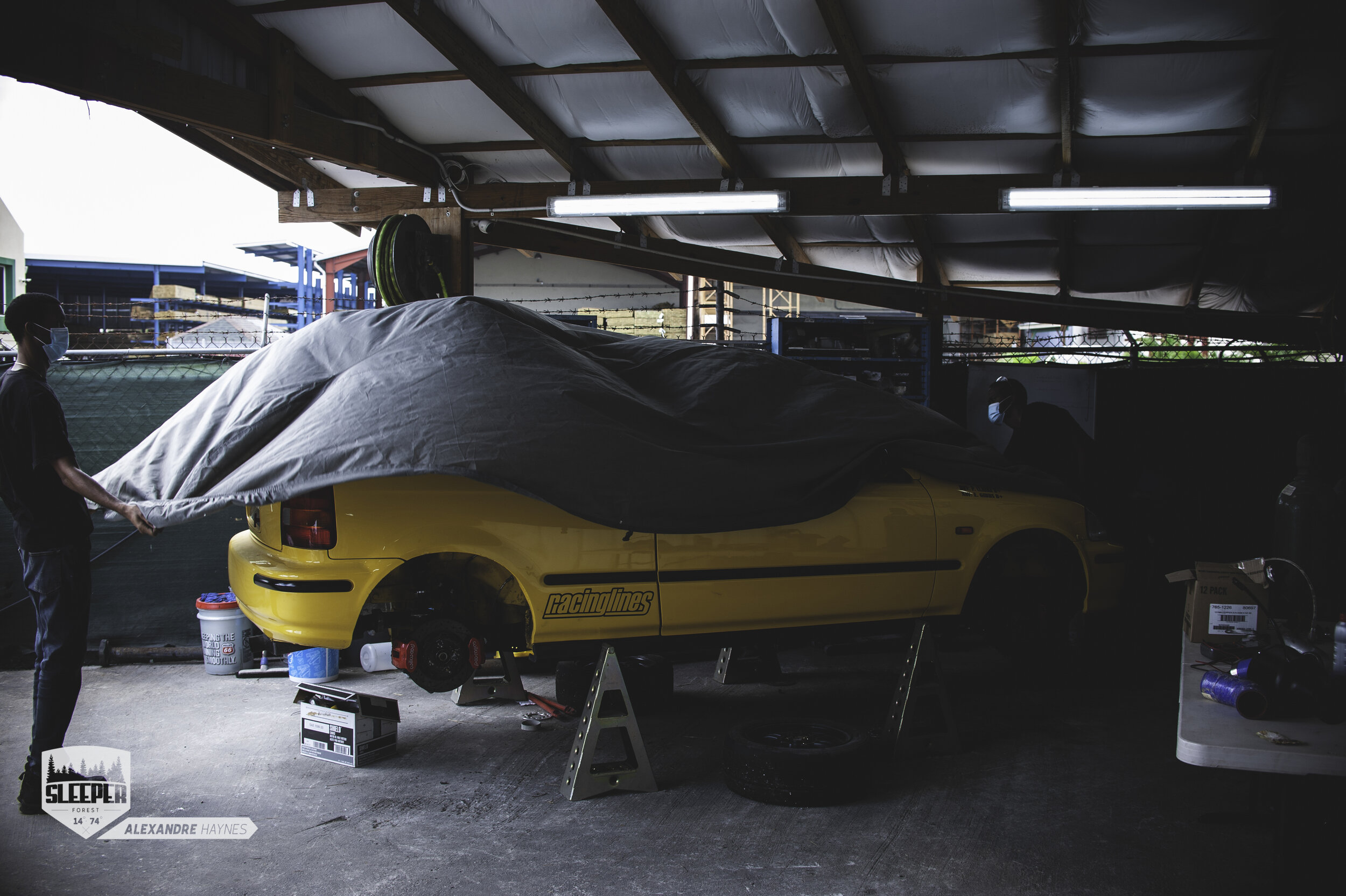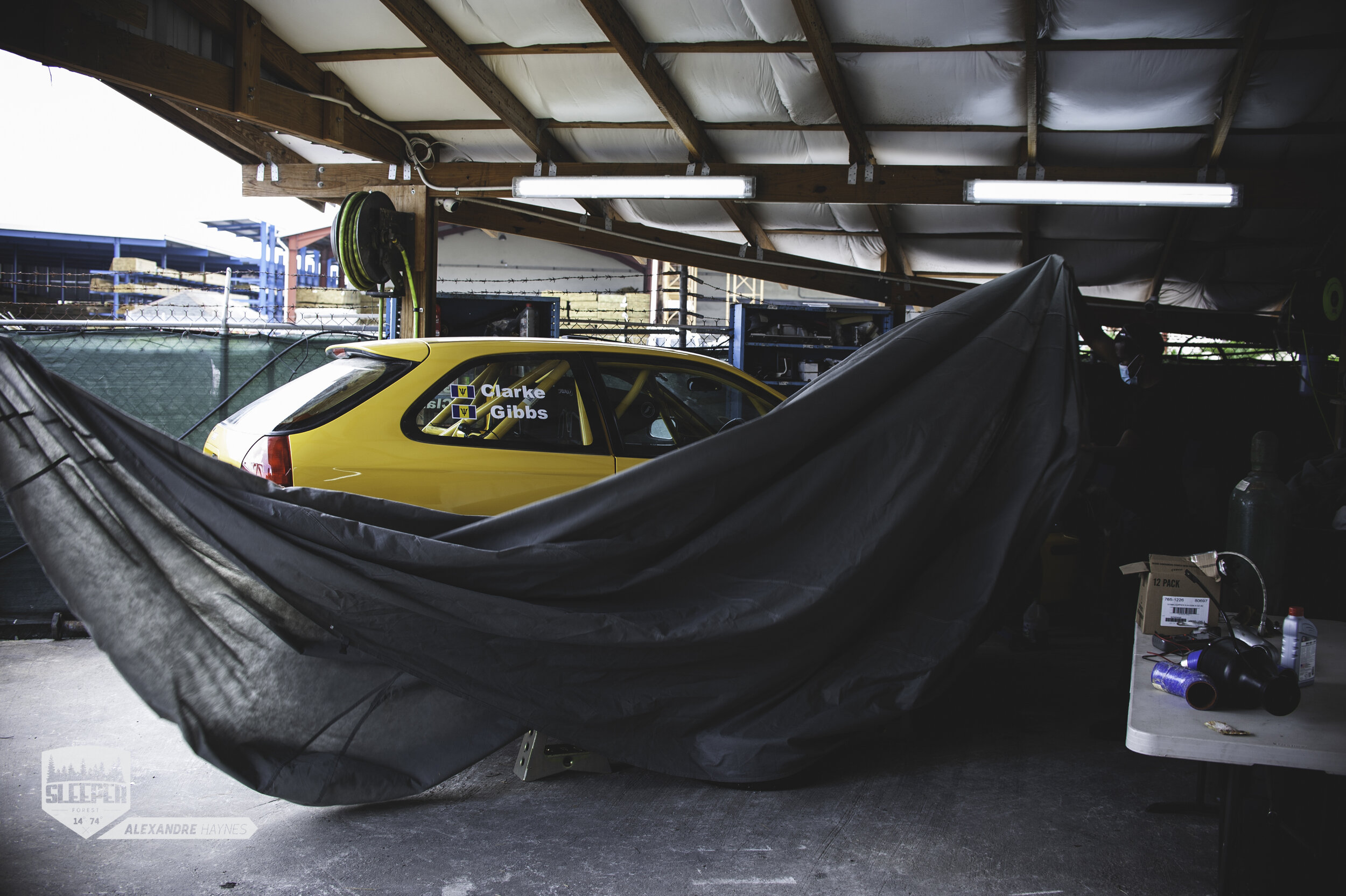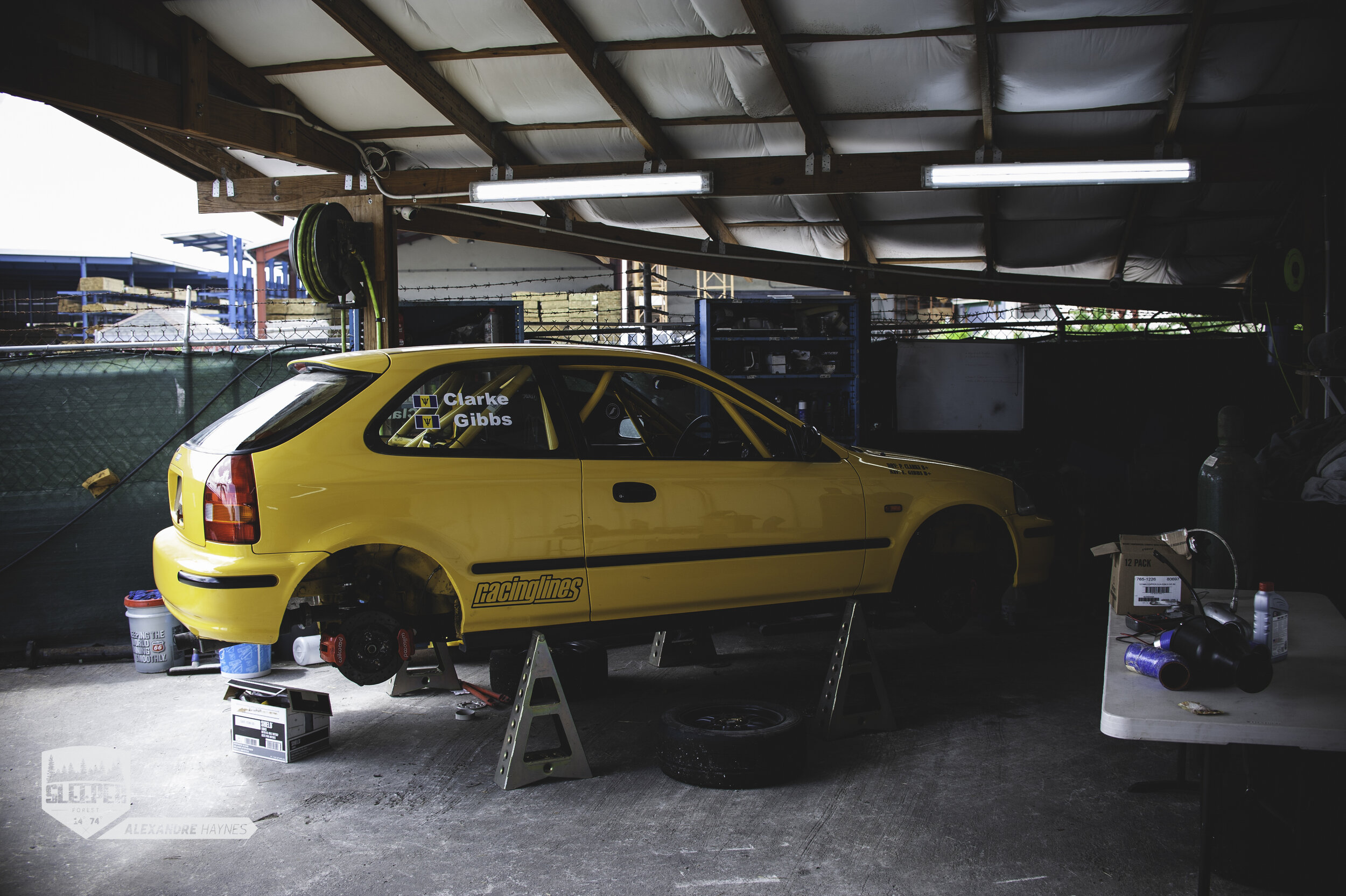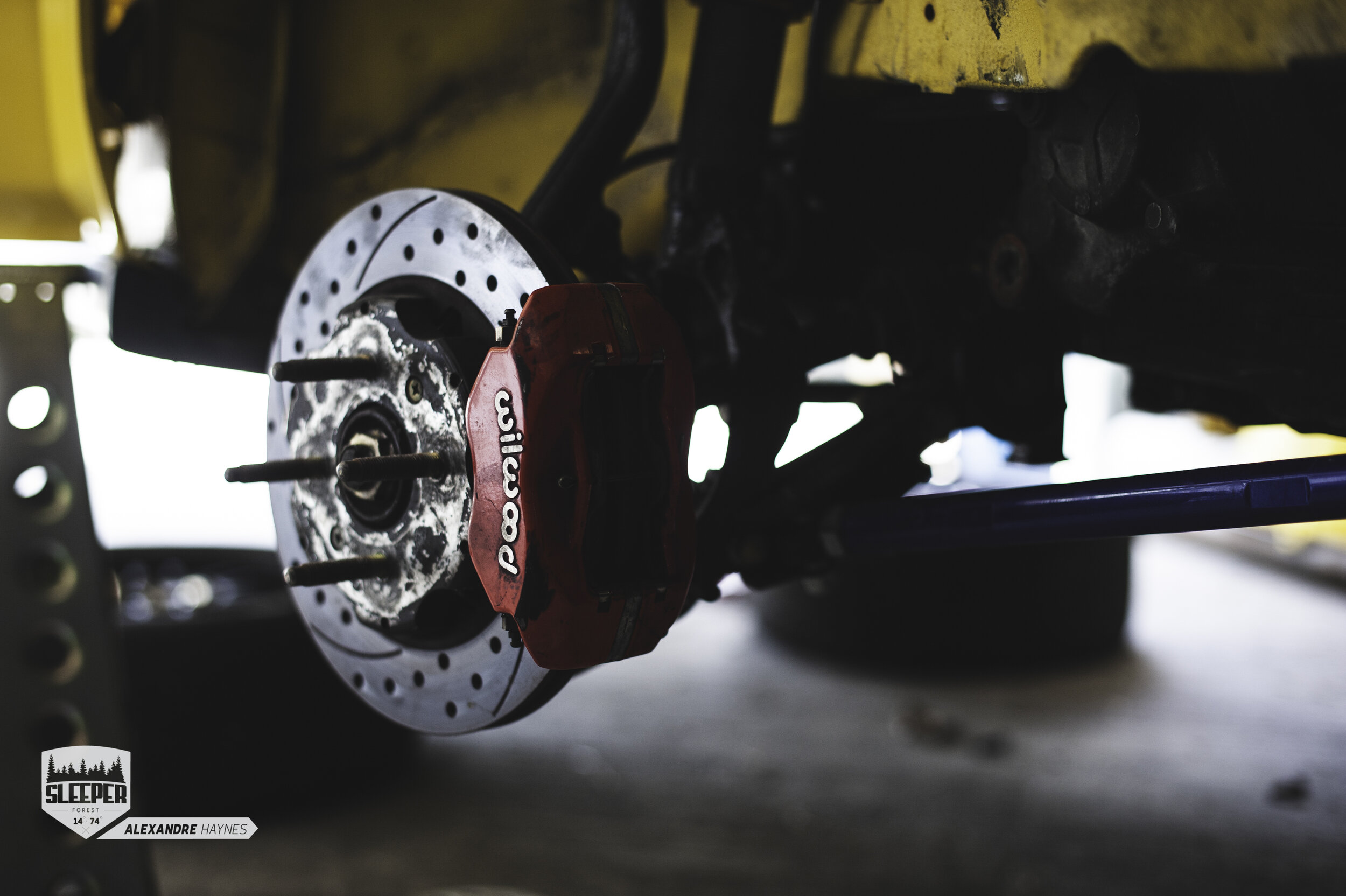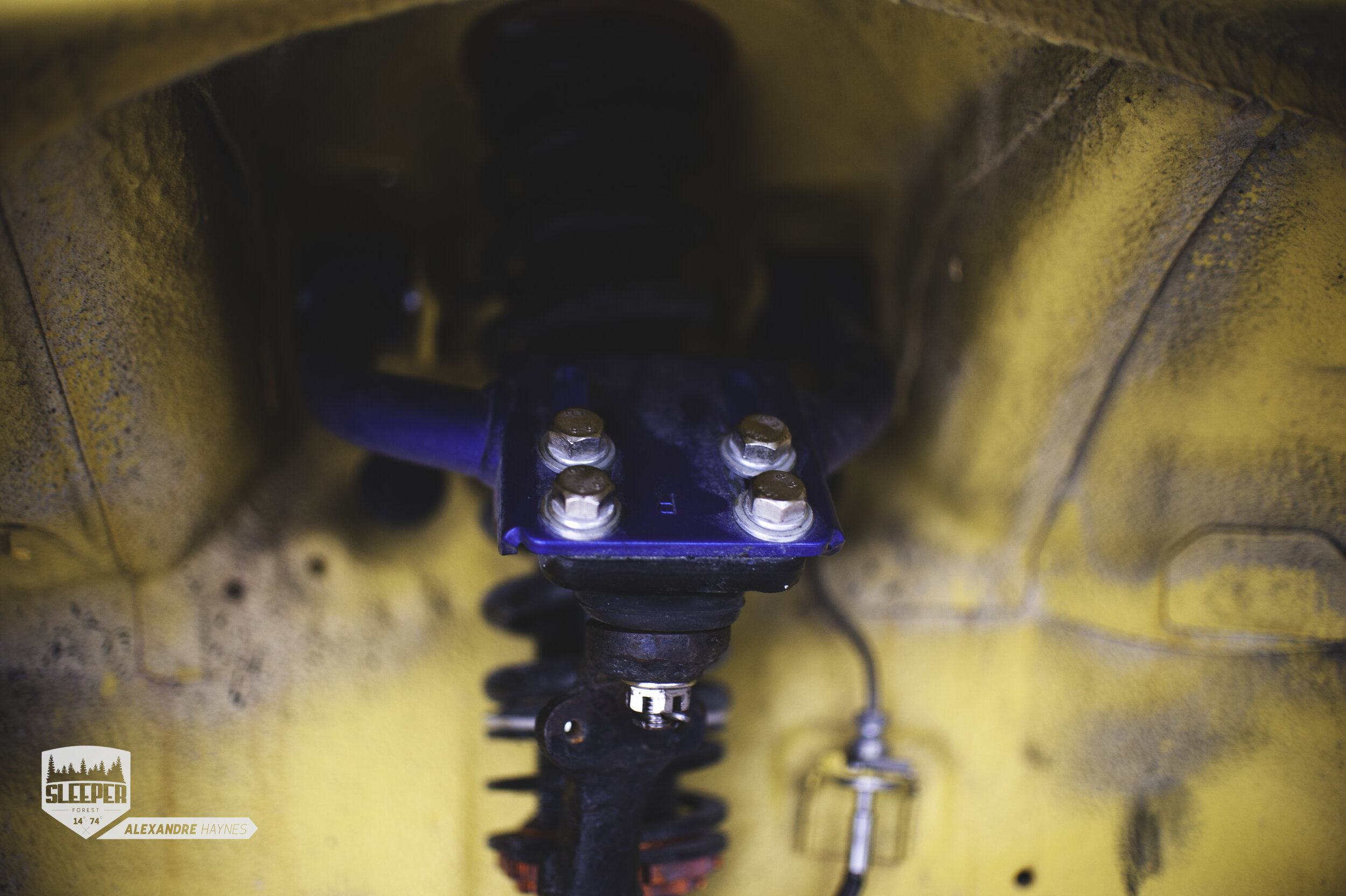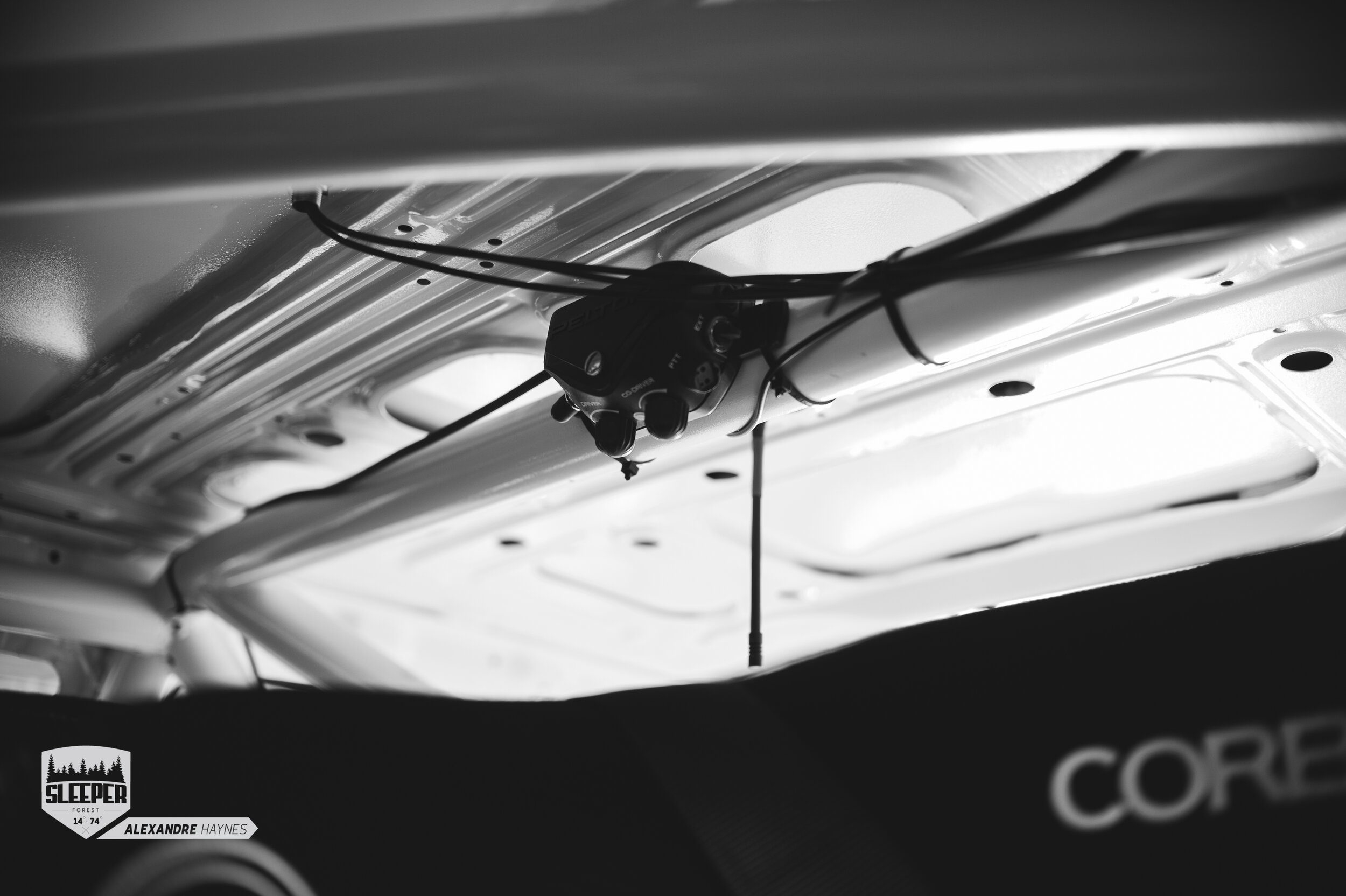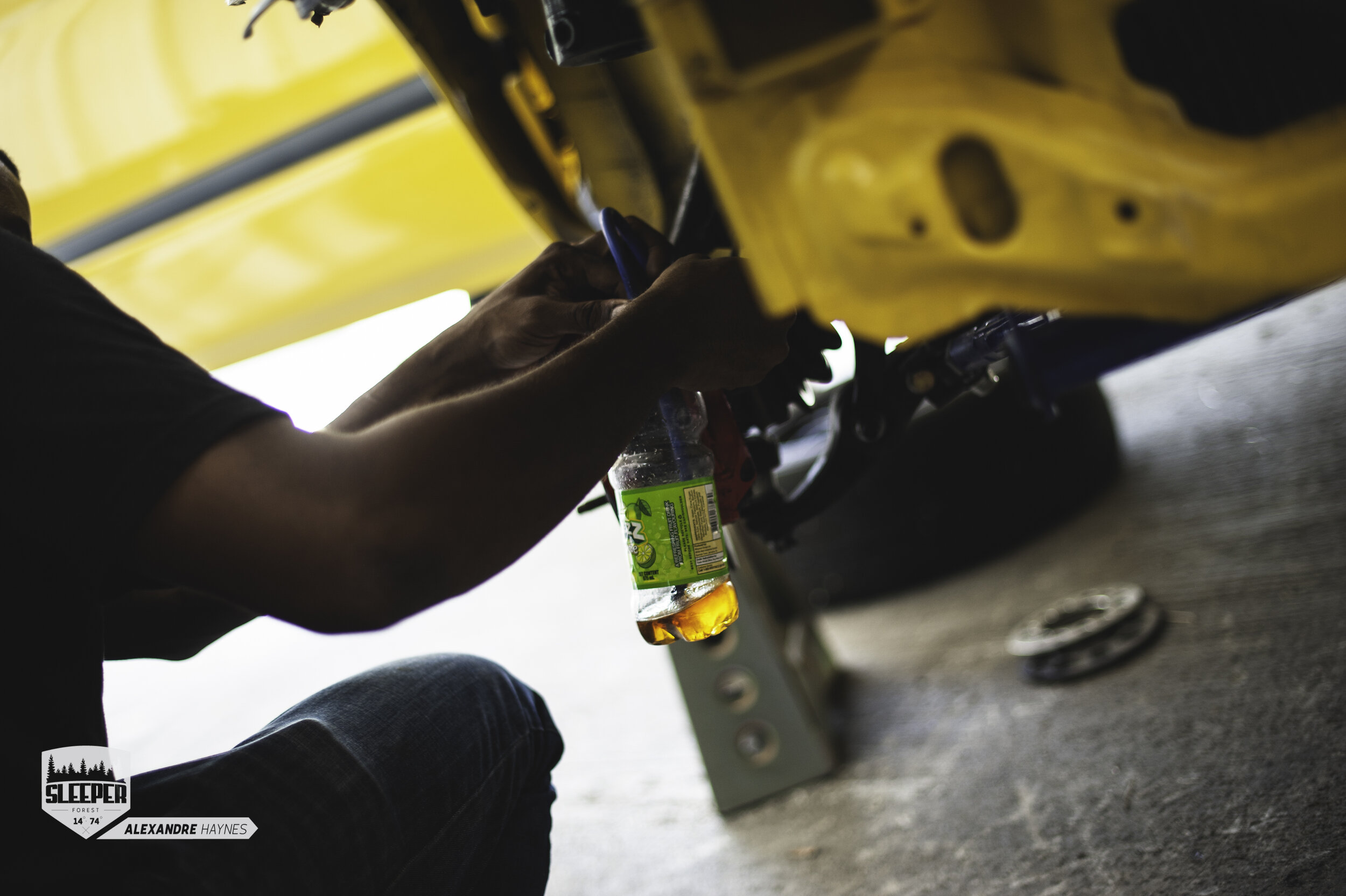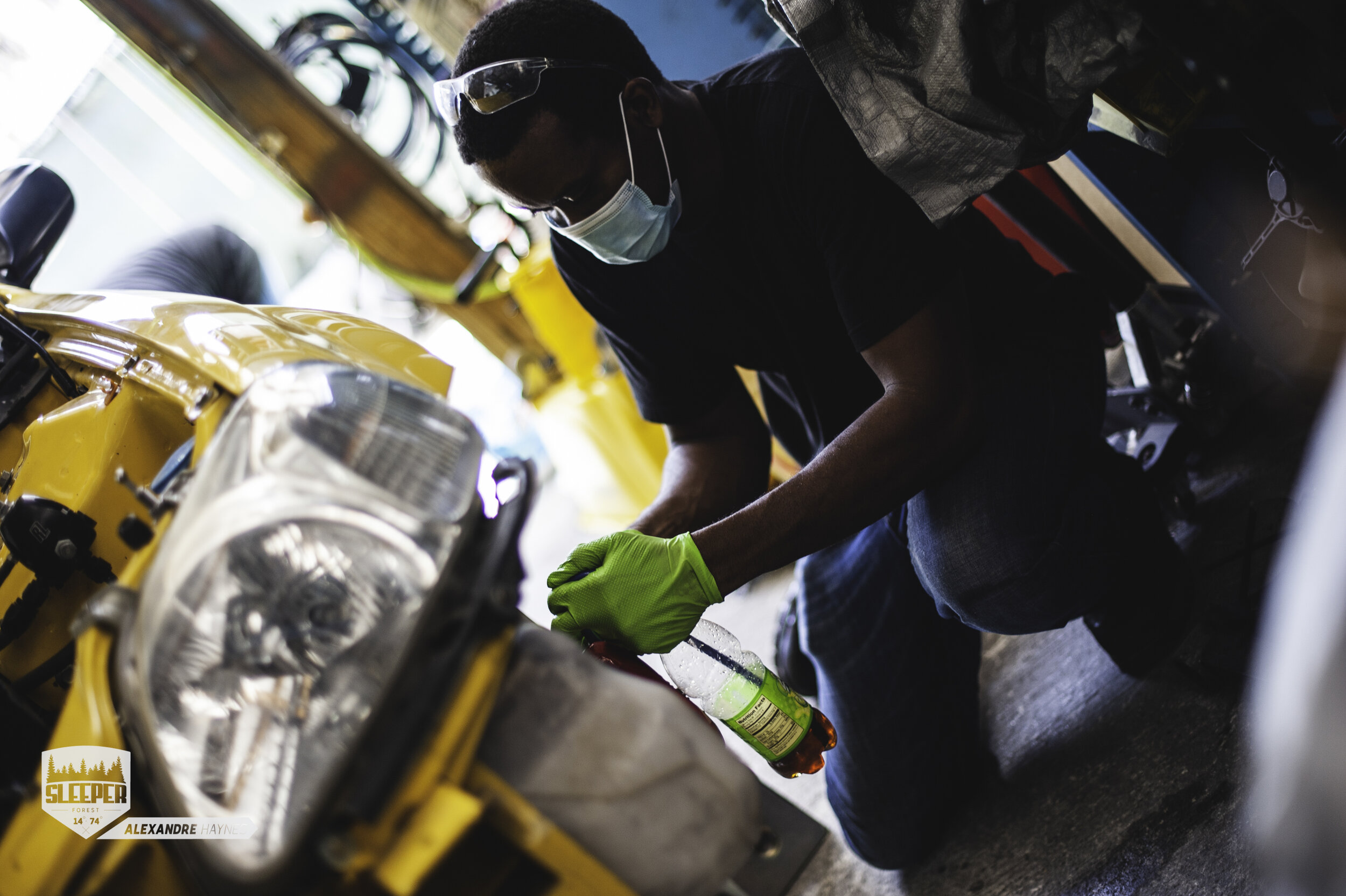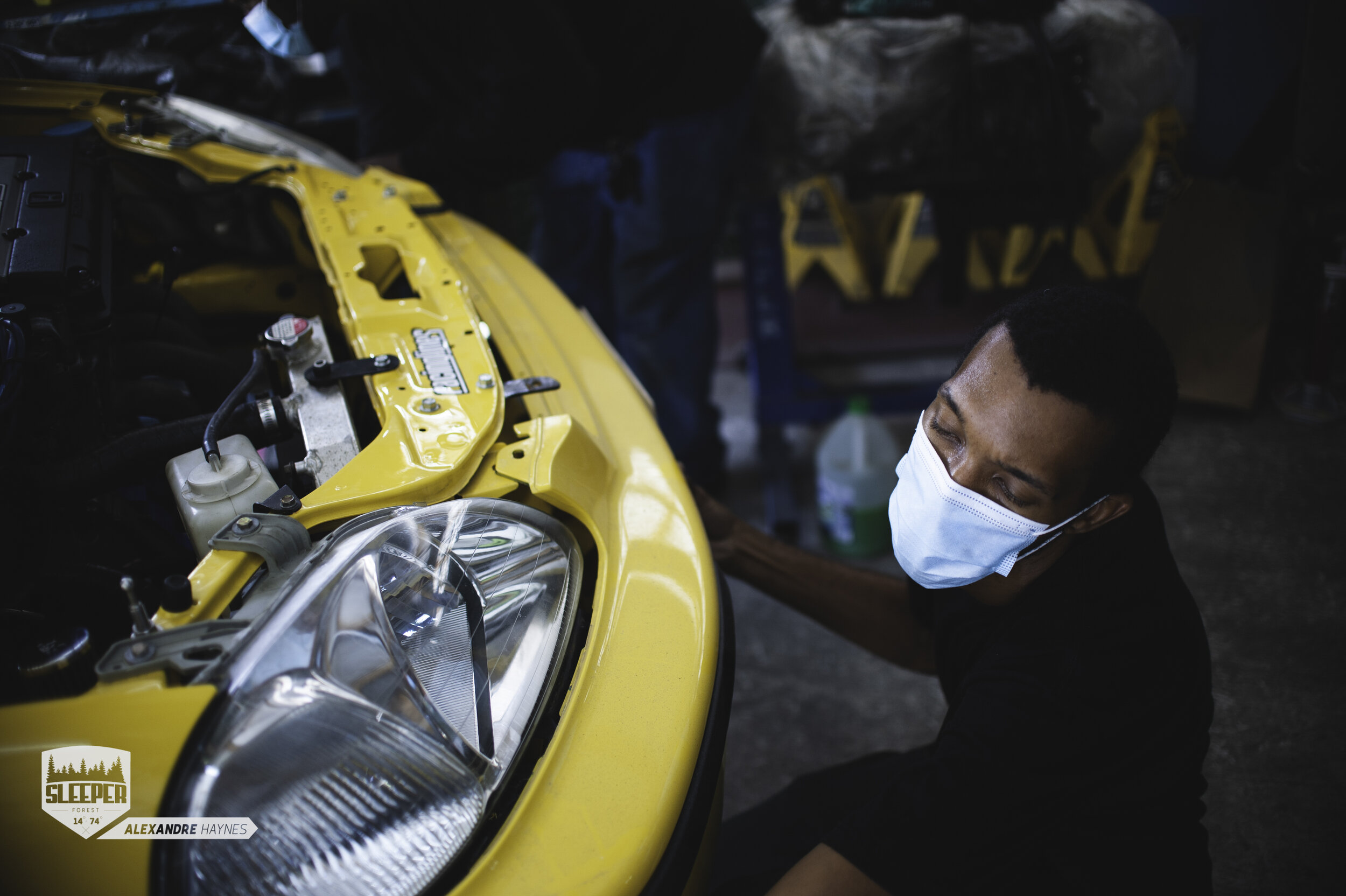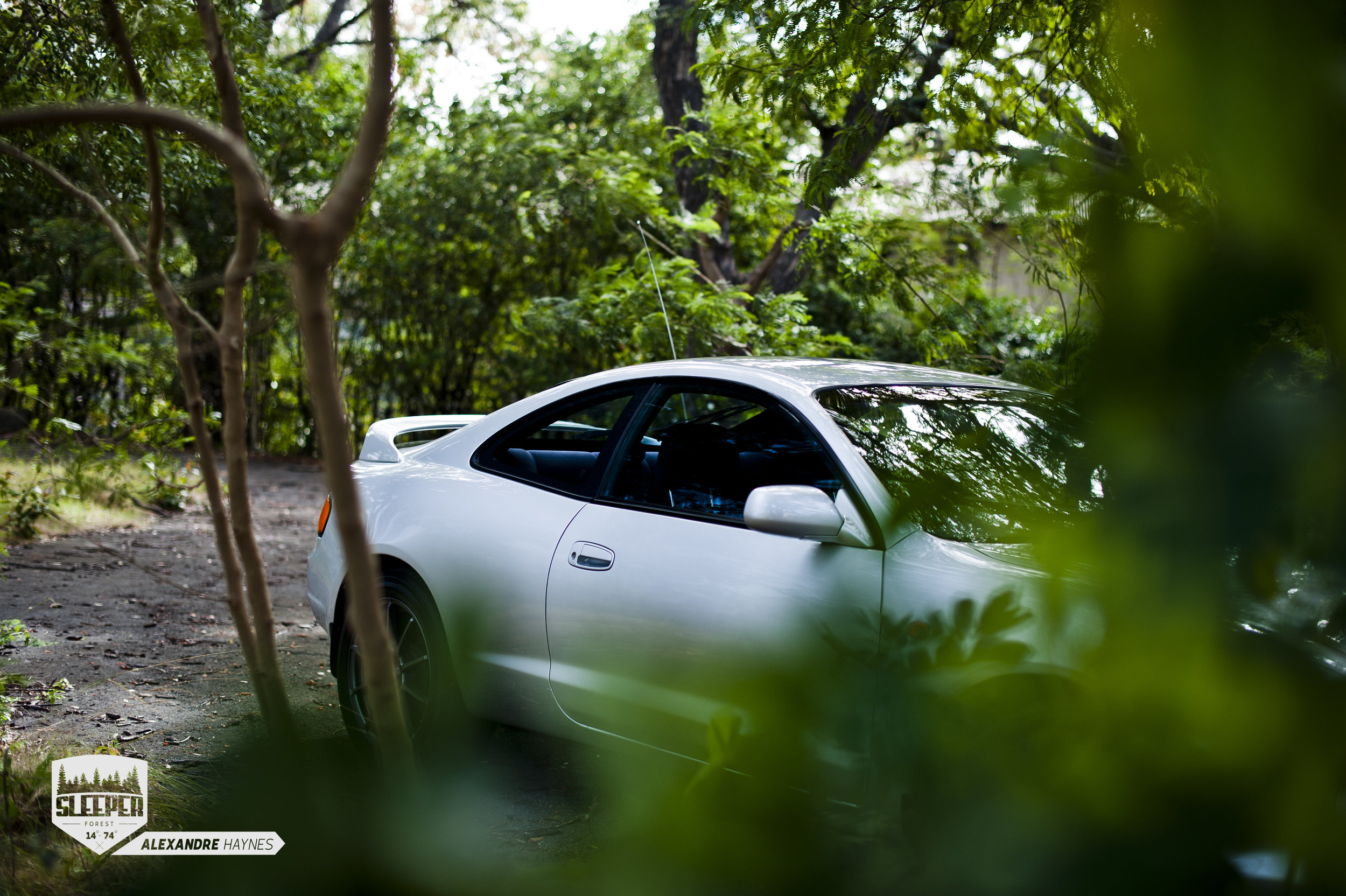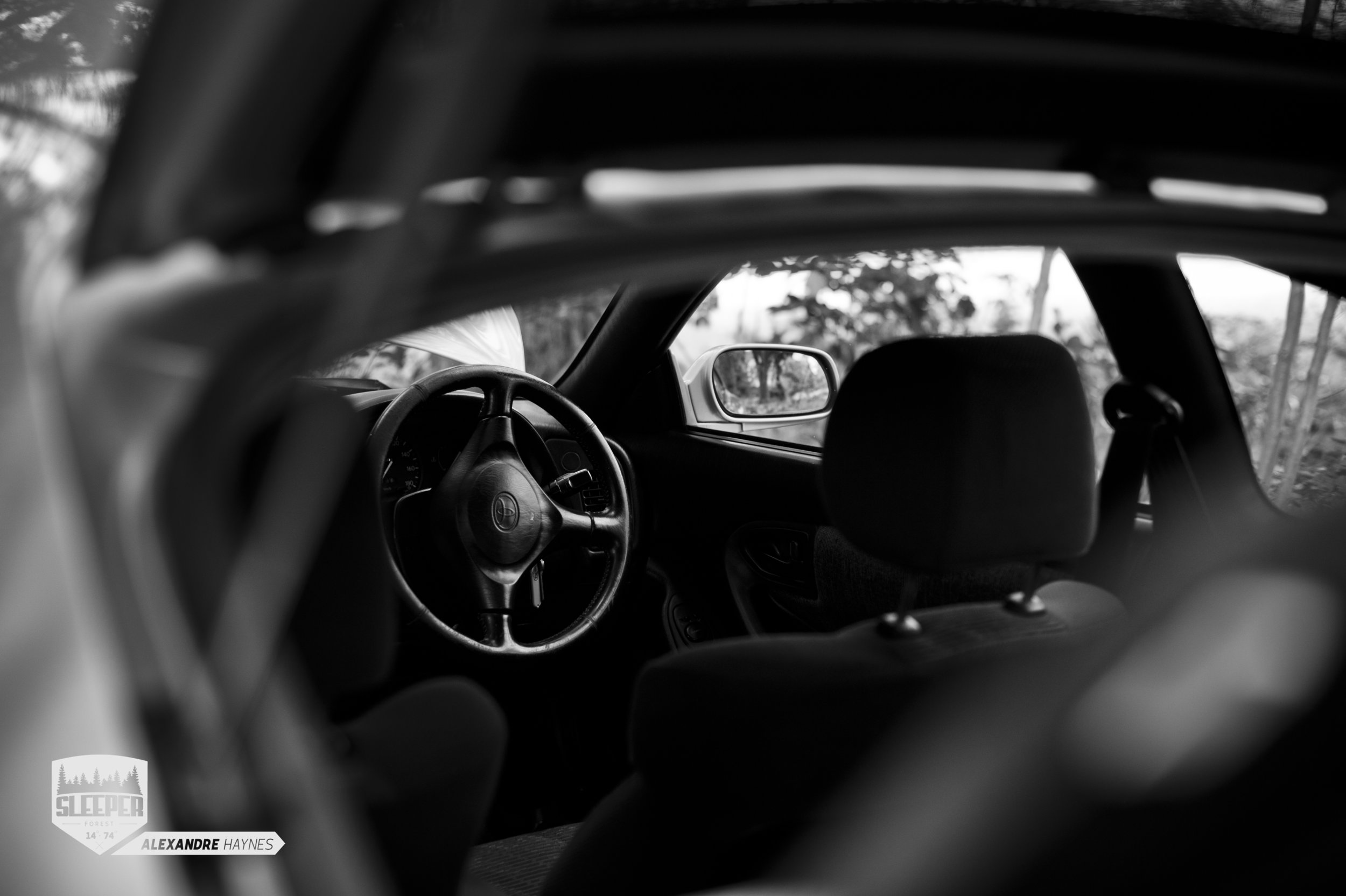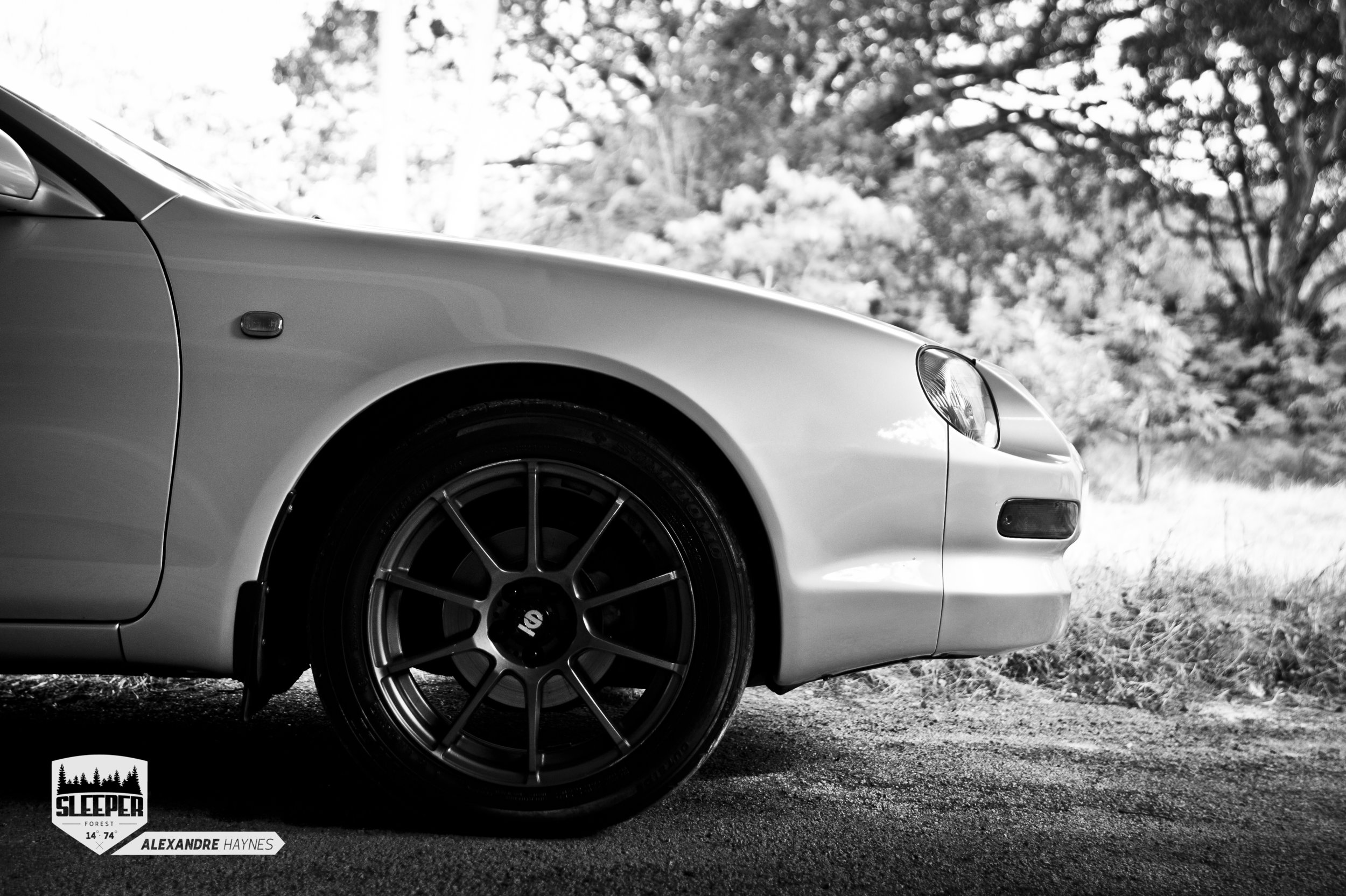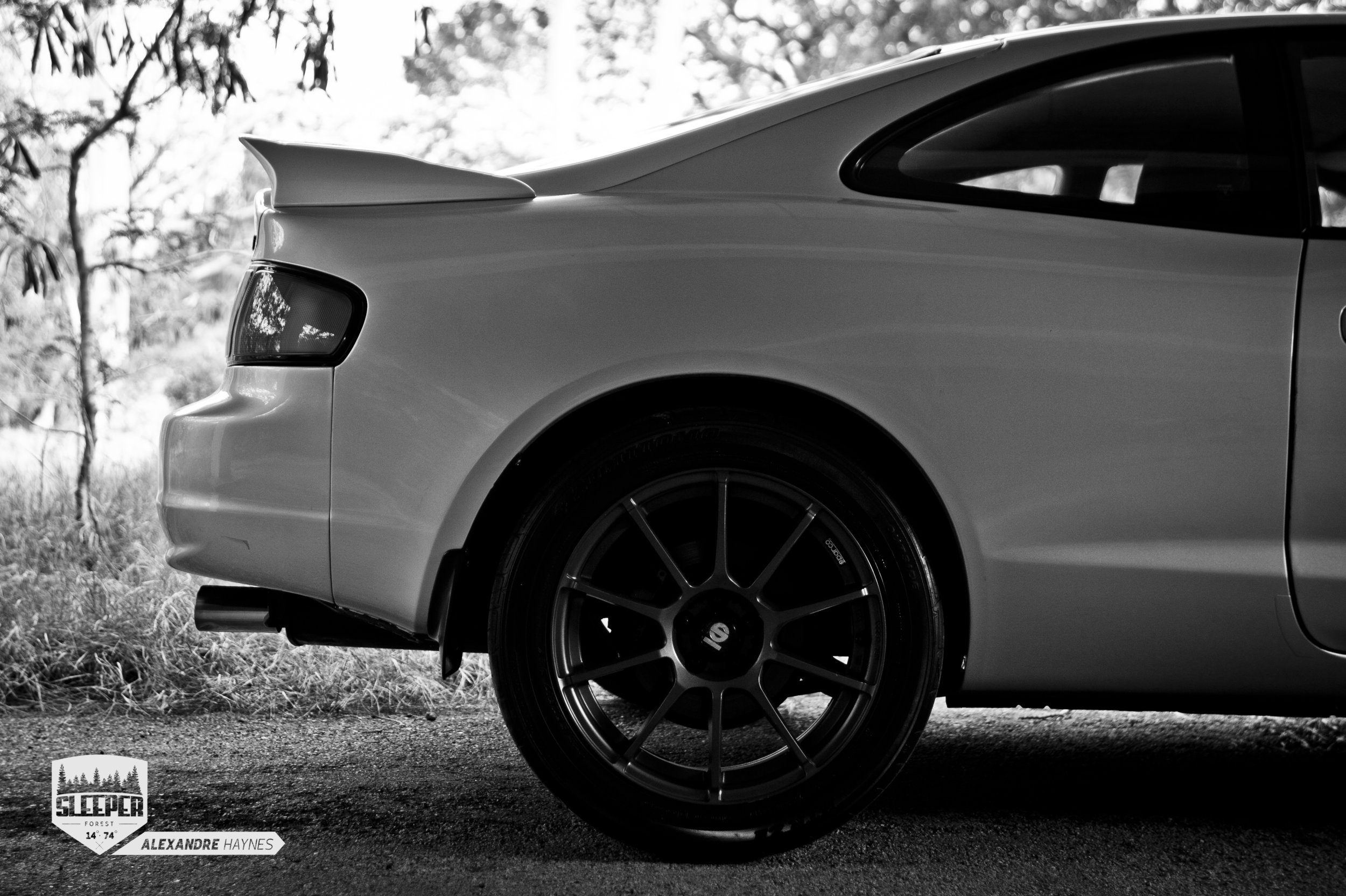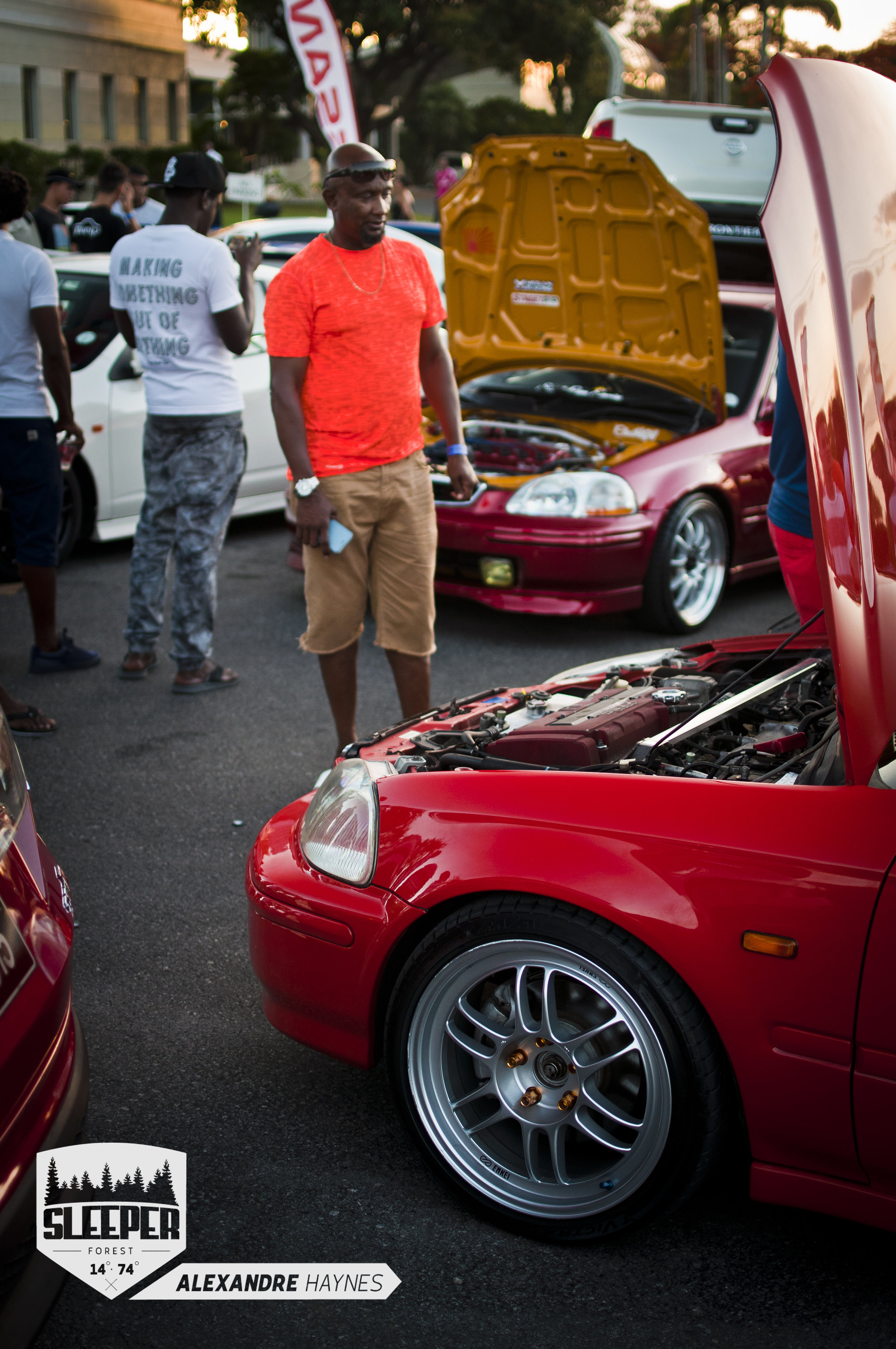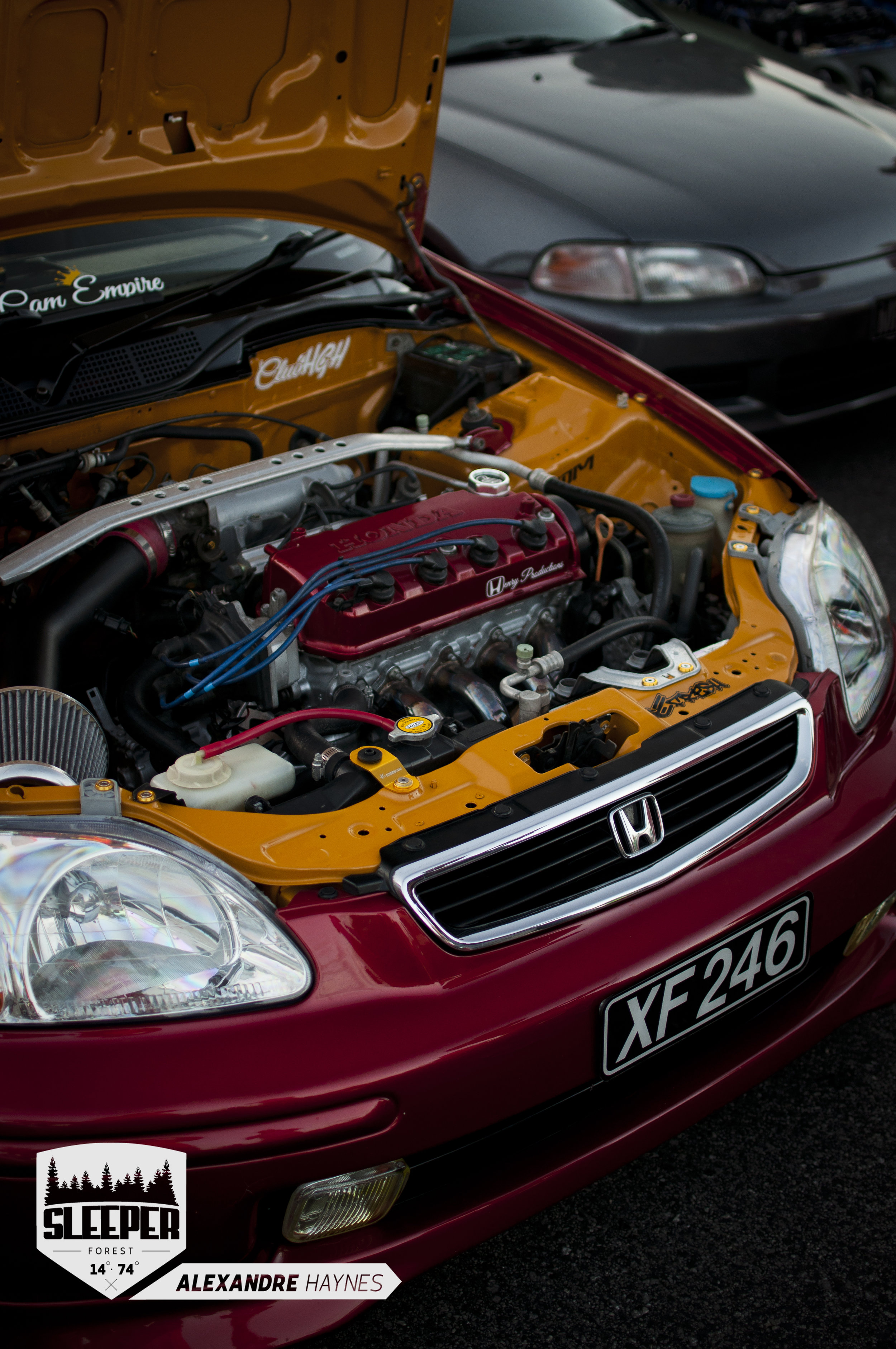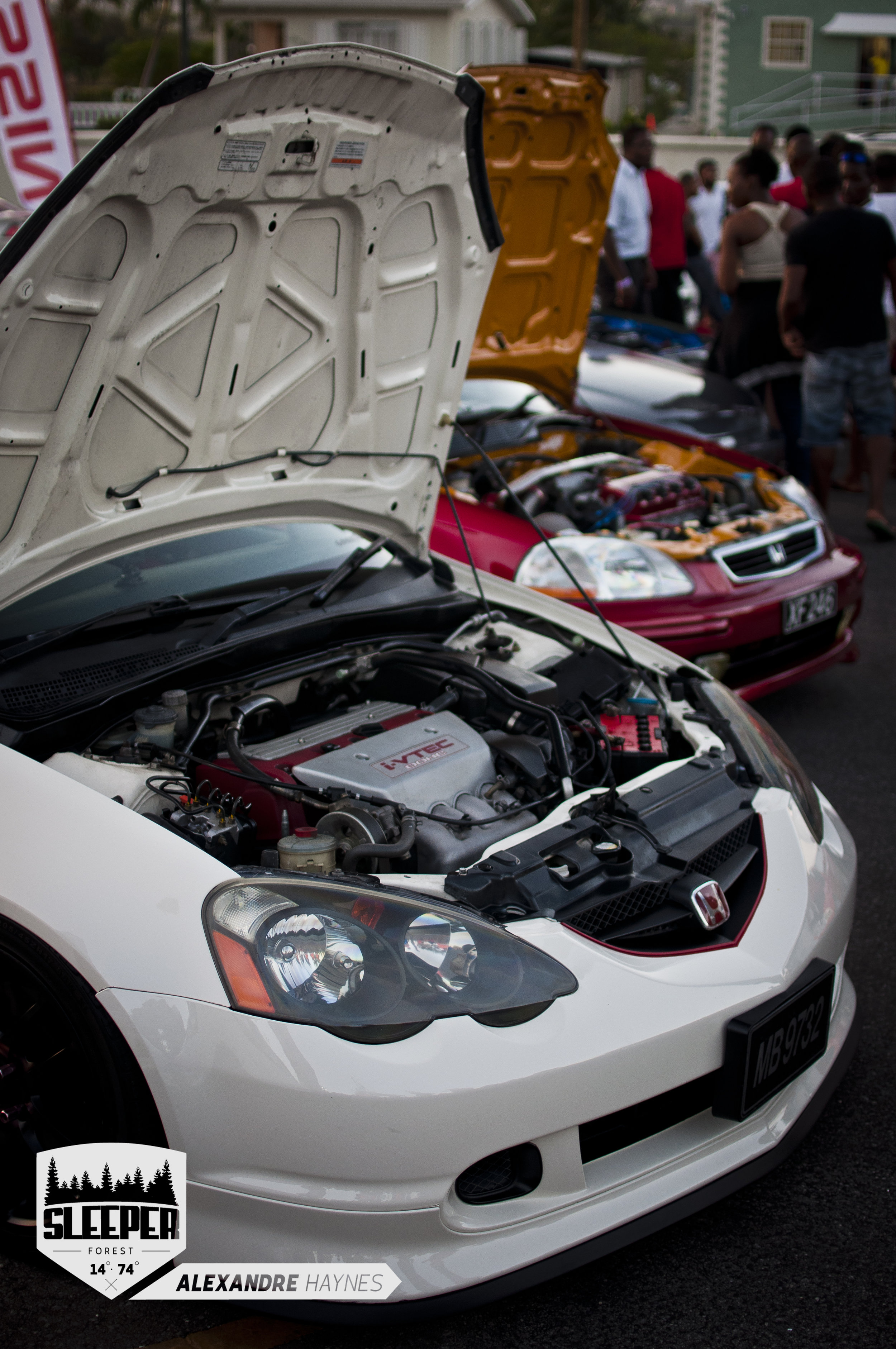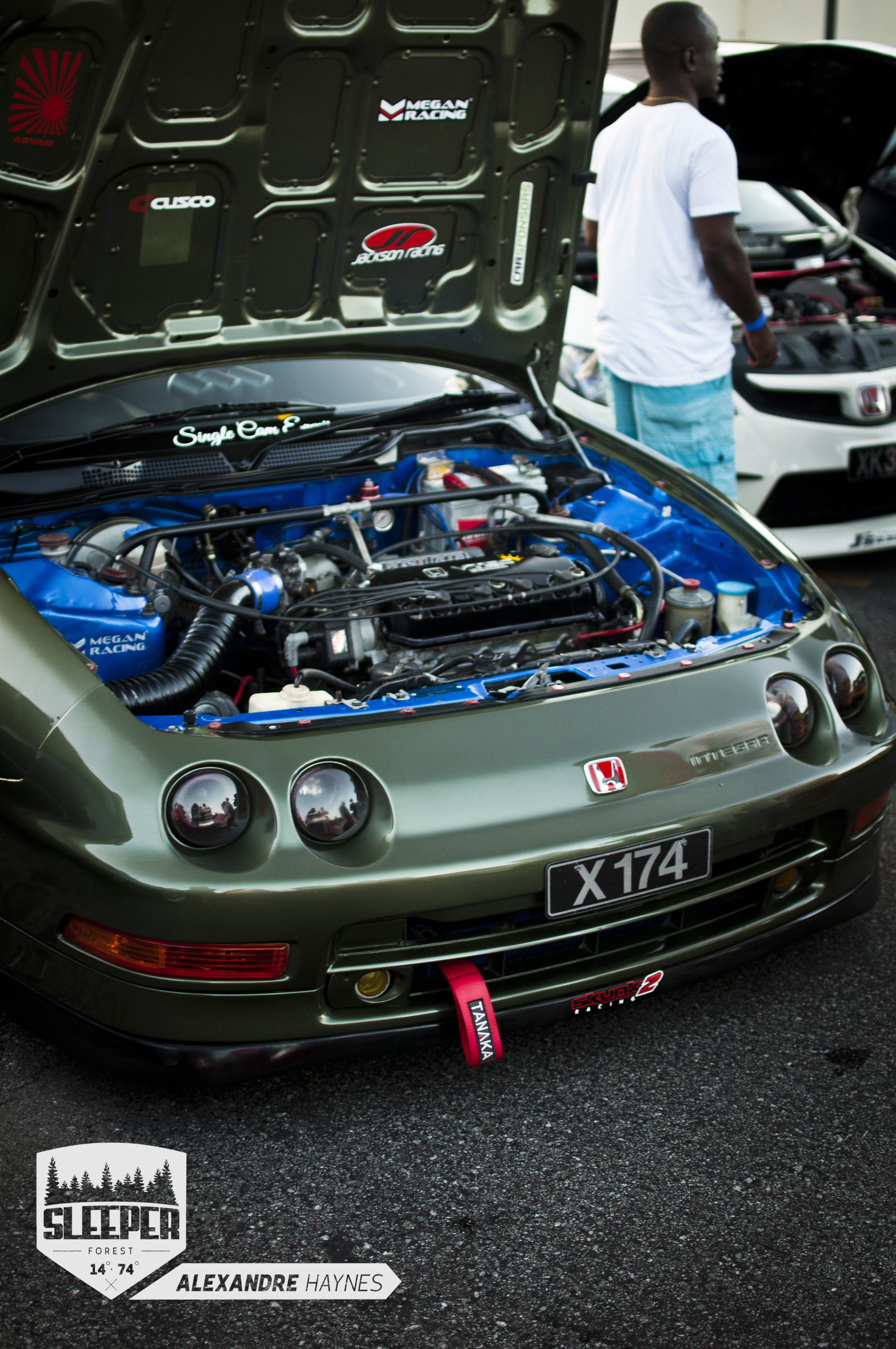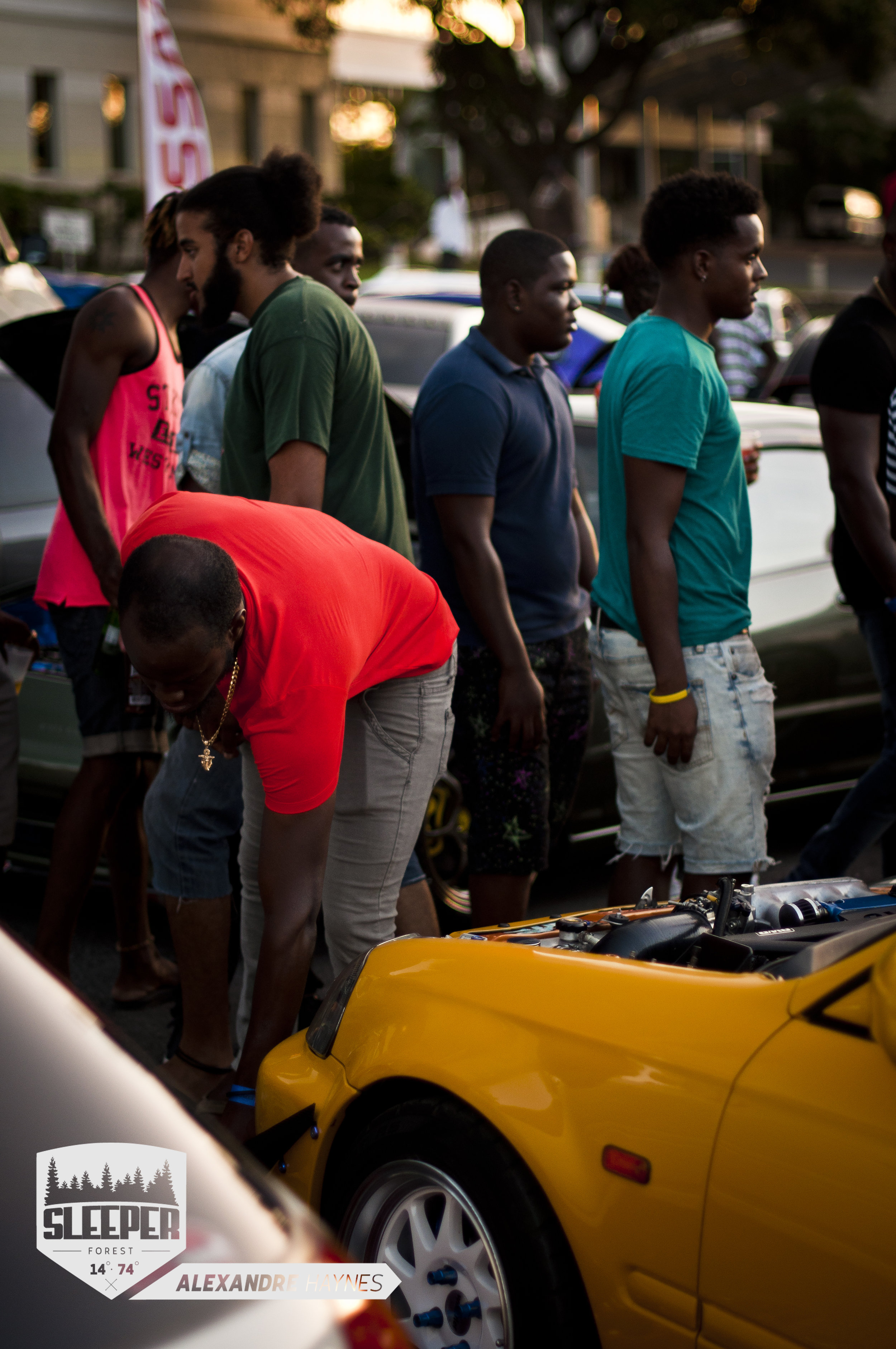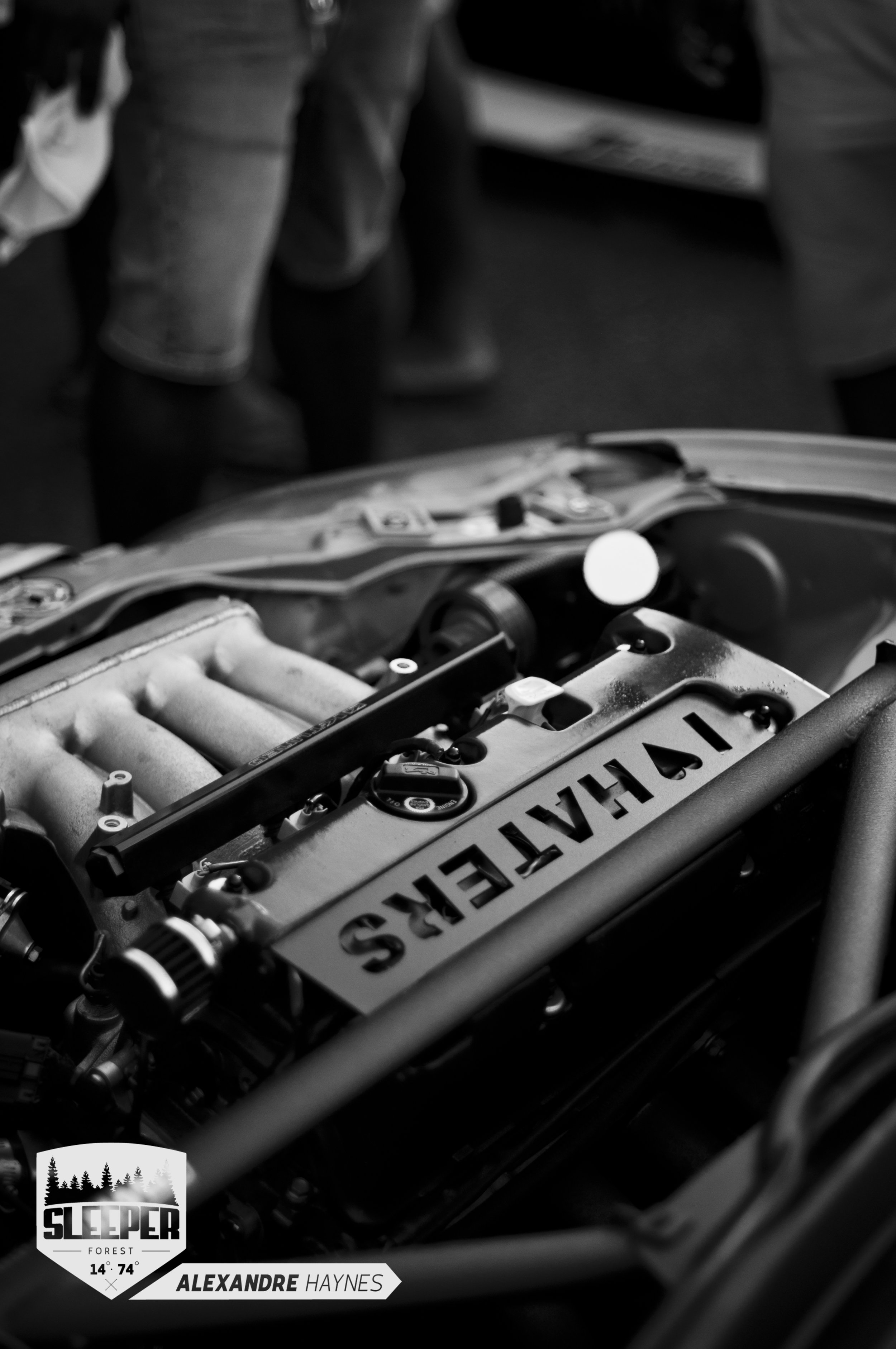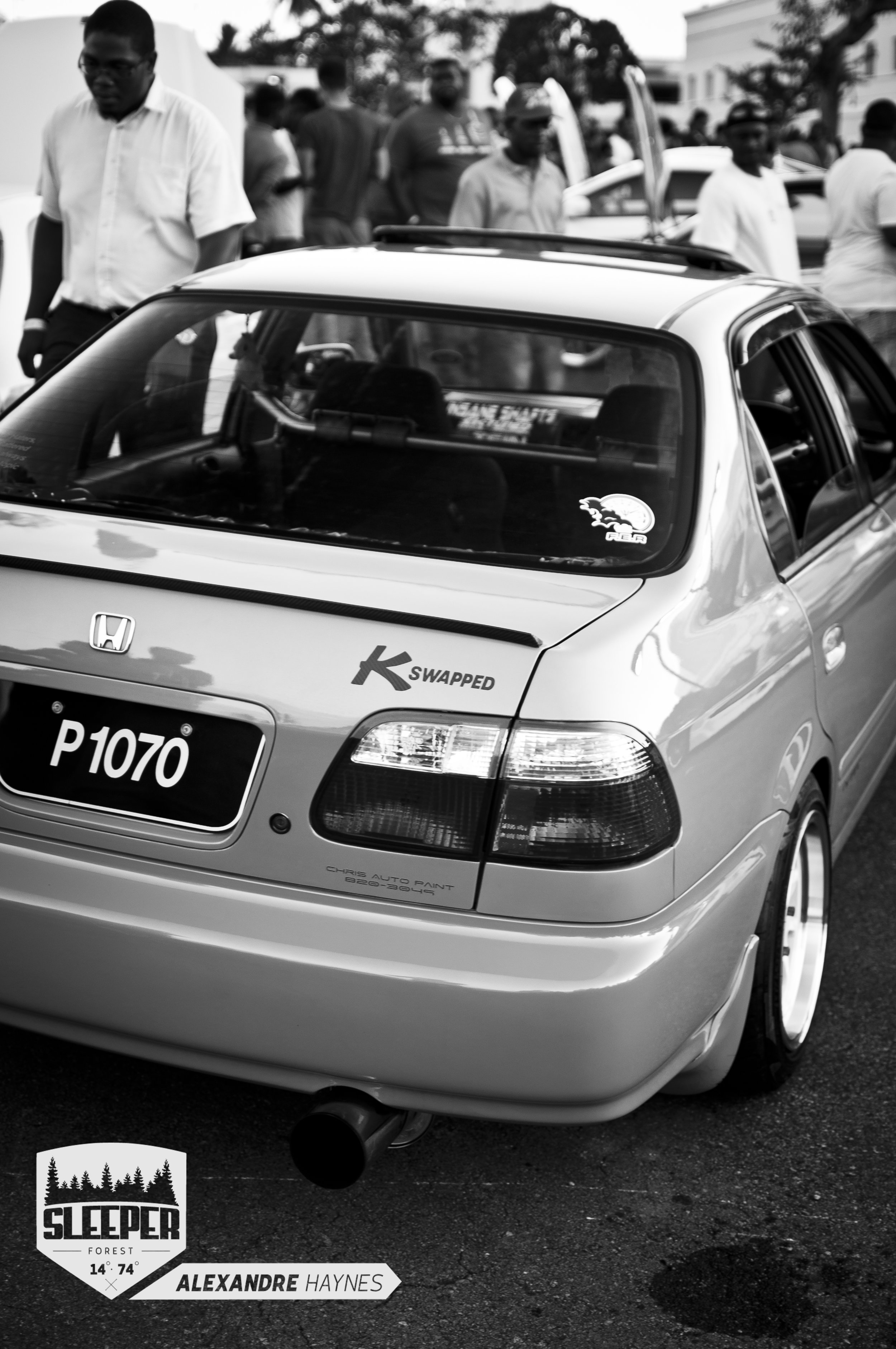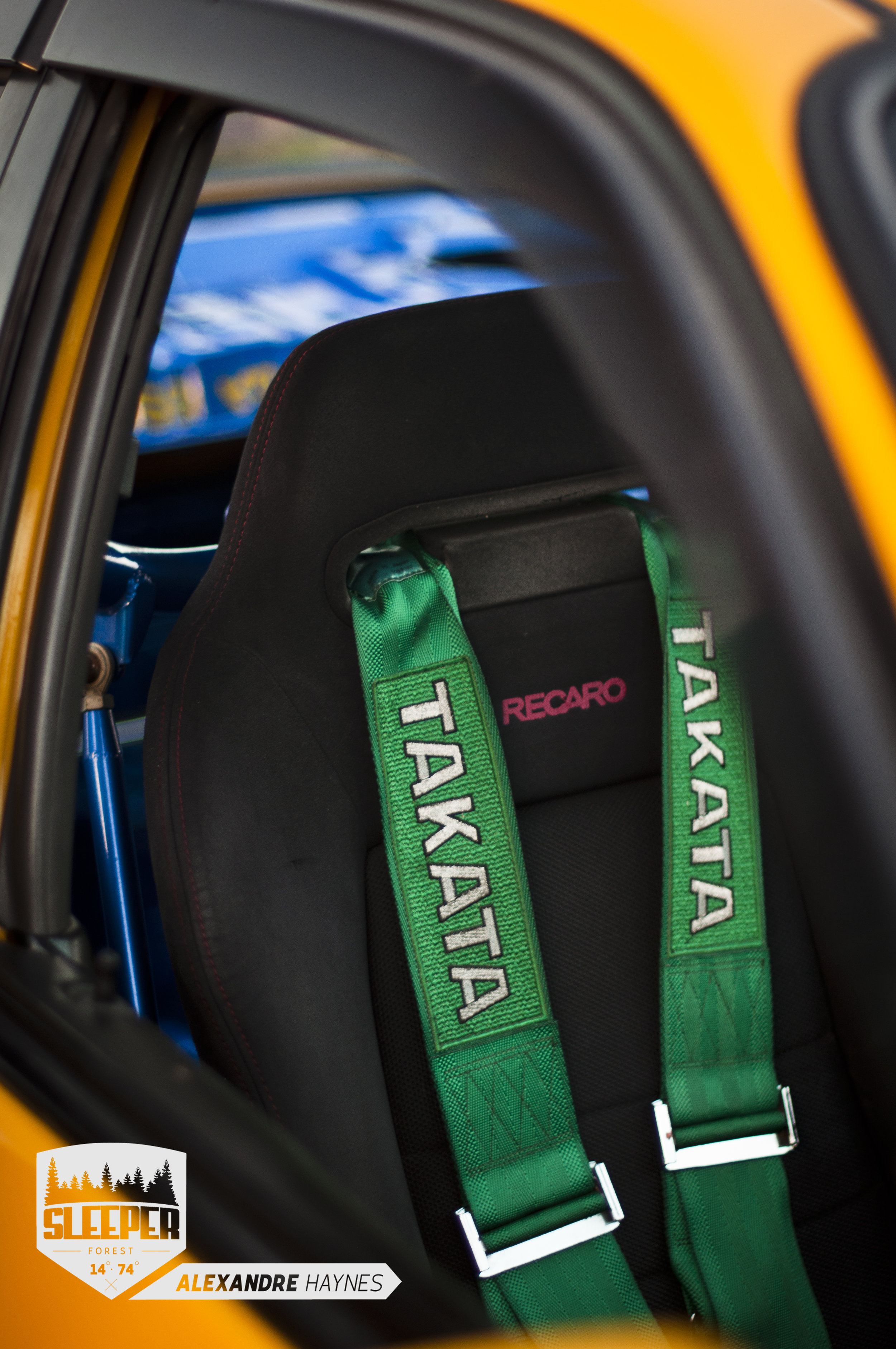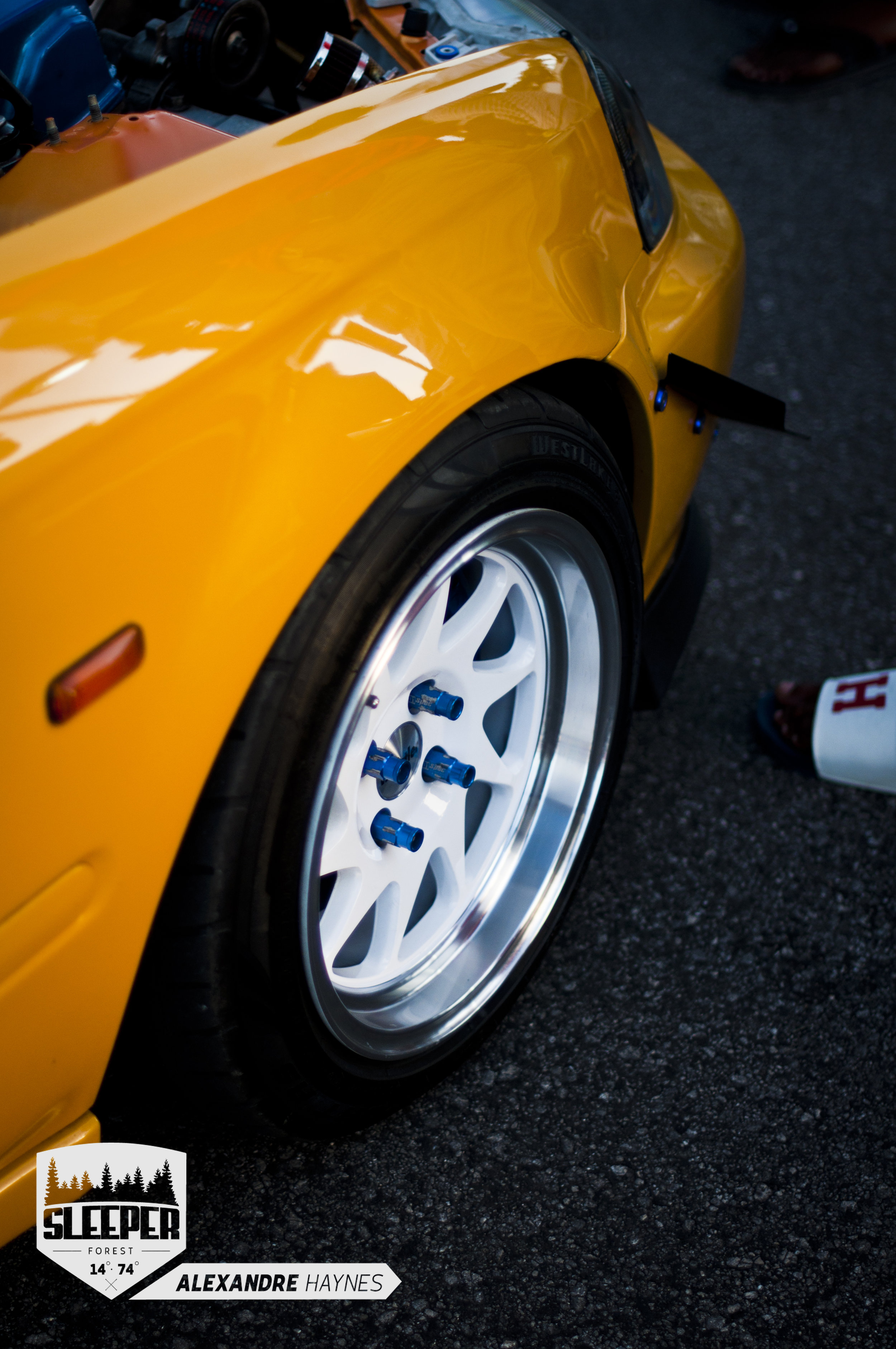This Canary's magic may surprise you.
To build a car correctly having a workspace to do so is important. What I really love about SDRR is the way they have taken a passion for working with the passions of their staff. The passion of Motorsport. They have allowed this car to be built on-site, and they have offered some assistance as well, for major hydraulic oriented parts and spares needed to make the build happen.
I think Rally has a lot of expectations behind it. There’s so much footage of purpose-built cars tearing up gravel, tarmac, and even ice stages around the world. Ridiculous anti-lag systems and fire all over their business end. Needless to say, this is why so many of us really love Rally as a discipline. Lets be honest, even if it was just a fad, we have all wanted to be a rally driver, in the hot seat of a car doing 160 kmph with only a twitch of the steering wheel separating you from a tree or post and shaving 0.223 seconds in a stage. What though, does it take to be a Rally driver? To have a car that’s competitive? To have that crucial ability to change adverse circumstances into learning experiences and character-building opportunities?
Meet Pierre Clarke. During the day he’s an employee of S.D.R.R Hydraulic & Industrial Spares Inc. (SDRR) here in Barbados, but on his off-time, he moonlights as a Rally Driver. He’s been doing pretty well too. We have covered one of SDRR’s cars already, a K-swapped Honda Fit. In their garage though, there was another project coming together, Pierre’s EK 4 Honda Civic. Despite the annual Rally Barbados season not coming off as planned because of the COVID-19 Pandemic of 2020, I am pretty glad I was still able to have a first-hand experience with the car being prepped and put together along with SDRR.
Pierre started rallying back in 2013, so he’s about 7 years into his rally career at this time of writing, and he really has had his share of trials. He’s experienced crashes, rollovers, and had to deal with the injuries that come with these. None of these have deterred him from pressing on. A serious crash can really damage your confidence as a driver, I’m sure many persons who would’ve spent some time putting together a rally car out of pocket, only to ram it into a telephone pole, trying to shave off half a second would rather just give up. Not Pierre, he pressed on, showing admirable tenacity about his craft.
There’s no magic behind a competitive car
Time for some hard truths! Magic doesn’t make your car fast, but when you build it correctly putting time and effort into it, there’s definitely a magic that results from the car. An important factor in building a car correctly is having a proper workspace. What I really love about SDRR is the way they have taken a passion for working with the passions of their staff. The passion of Motorsport. They have allowed this car to be built on-site, and they have offered assistance for major hydraulic oriented parts and spares needed to make the build happen.
Pierre has experienced the bittersweet challenge of building a second a rally car. He decided to start with a good base. He acquired his EK 4 out of the UK, where the team at Racinglines oversaw the preparation of the car, so it would meet the safety requirements for a rally. Class requirements limit the number of engine options available for the car. Pierre competed in a class that’s similar internationally as Clubman last year, but now the car is in Modified 1 (M1) class. This means he has to keep the car, drive-train wise, pretty close to what it would’ve been built with from the factory but he’s allowed some slight modifications. The Honda EK series, saw it’s halo engine with the EK 9’s Type R variant, which used the B16 motor.
This B16 despite being a halo engine doesn’t mean it can do without modification. In fact, this is really Pierre’s first time using an engine that has been modified, it’s only smaller mods that help with the flow of the head. He’s replaced the factory throttle body with a Skunk 2 throttle body, and he port matched the manifold so it opened up to the head more. He also dropped in some larger cams in the head as well, this pushed the power band of the engine more to the top end where it would usually sit during a stage.
On the Exhaust side, the same treatment of port matching was used; this helped the exhaust gasses escape at a higher rate. What this means is that the engine will breathe better and be far more responsive to throttle positions. Besides this, the engine is still pretty much a standard Type R B16 motor.
The oil pan was baffled, to prevent oil starvation during cornering. This by far is one of the most important modifications you can do to a race-oriented engine. Especially a front-wheel-drive car. Oil starvation is probably at the top of the list of things that kill an engine in a build. Keeping engine temperatures down is also important as well because the engine is mildly tuned, a standard double cored half size radiator and an oil cooler will do the trick for the coolant, and this Setrab oil cooler works for keeping the oil temperatures down in the car.
Showing an image of his modified oil pan
Sure, this is a standard B16 with a few mods for flow, it’s nothing over the top, but it’s reliable, it has never stopped running and it’s putting its power down to the road. In a rally, this is by far more important than an engine at its limit thats unreliable and finicky. The engine of a car doesn’t make the car entirely, it’s what the engine is teamed up with that’s important. The chassis, and the suspension.
AN old block
A drivers’ Car
I’ve mentioned building a second rally car as a bittersweet experience. This refers to the gains and losses incurred when it comes to what a team would’ve spent on development for the previous car and what goes into the new car. Pierre would’ve spent a few years developing the car as a package which made it competitive for him at that point in time. The team would lose that research when going into a new chassis. On the other hand, a new platform brings with it, new possibilities. This can change for the better what you may be able to accomplish in a season, and so far, despite some hardships last season they are confident the car’s weak points are now covered.
It’s a spartan interior. Just the essentials are displayed on the dash, it’s funny, but he doesn’t use a speedometer, no time to check how fast you’re going when you’re going fast, it’s ironic. The tachometer and the shift light is very prominent, as well as water temp, and oil pressure. The car still uses the standard gearshift, it feels “notchy” enough and it communicates well with the driver.
Ah yes, the pedal box was completely changed to this Tilton kit, which gives great feedback when it comes to braking, the brakes are now fully manual, and it takes some getting used to, really have to press the brakes like a madman. This is a huge modification to the character of the car. We take it for granted how easy our vacuum-assisted brakes are, but having the tactile feel of your calipers on the rotors can really be intuitive when it comes to gauging needed stopping power for a rally stage. When a driver climbs this learning curve, it’ll be difficult to go back to the more humane way of braking.
The team has invested man-hours making this car a driver’s car. Rally is a sport, where drivers gain one up on their competition through corners, and driver confidence. Class restrictions, call for limitations in power, so gains are made where the car makes contact to the road. This is why trust in your machine is so essential to making a car competitive.
With added suspension modifications a car will corner at higher speed. This in turn changes the fluid dynamics of the car’s factory fuel system. A car starving for fuel, won’t be competitive, this fuel system was built entirely in-house at SDRR, with a surge tank which keeps fuel under pressure, this negates side to side movement, and gives the car a constant fuel supply in any situation.
A rally Car takes more than just a driver
When it comes to Rally legends, we talk about the names of the drivers, sometimes the name of the co-driver is lost in the fanfare so imagine what happens to that engineer who found the issue in a gearbox at the service stop, or the engineer who patched together a fix so the car could go on to win. We forget that it’s not the driver that makes the team great but it’s the results of the chemistry of a group that comes together with a specific goal in mind.
They are some persons on the team though, who weren’t physically there while I was shooting this article, but I could see the results of the work they put into the car. The core team at SDRR and Pierre’s co-workers really do share that same passion and love for Motorsport. Birds of a feather really do flock together and it’s exciting to see what results with when the opportunity arises.
At the outset, I asked 3 questions. What does it take to be a Rally driver? What does it take to have a car that’s competitive? What does it take to have that crucial ability to change adverse circumstances into learning experiences and character-building opportunities? From what I found it, I think I can answer those 3 questions, firstly it takes tenacity and perseverance. Secondly, there’s no magic behind a competitive car, take your time and do your research, build it to the specifications you need and drive the car so you can make more realistic decisions about what changes need to be made. Lastly, how can you take adverse circumstances and turn them into character building opportunities? Facing your weak points, working on them and having a reliable team, that bolsters confidence when looking into the unknown.
Finishing up the shoot and interview with Pierre and the team, we left off with the car basically reassembled and starting. A video of the car will be posted so you can take a look and hear what it sounds like for yourself. Pierre was waiting for his exhaust manifold to come back from the fabricator. This won’t be the last we will hear from them. Once the car is up and running, look out for another update on this Canary. I was really happy for the chance to work with SDRR to make this content!
So until next time! Happy Motoring!
Follow Sleeper Forest on Social Media!
Instagram
Facebook
Sleeperforest_alex - That’s me!
This Toyota Starlet EP82 is going to be the death of me
Every project needs to start somewhere, and bodywork was definitely on the top of the list along with suspension (more on that in another update), especially when you have a couple mini rust craters on the roof.
A car manufactured the same year I was born, a car I had always loved and now a car I own, this Toyota Starlet EP82 is going to be the death of me. It's either going to work me to death or I'm going to get my head chopped off for all the money I’m going to throw at it over the years; one way or another, this love child is here to stay.
Every project needs to start somewhere, and bodywork was definitely on the top of the list along with suspension (more on that in another update), especially when you have a couple mini rust craters on the roof. I neglected it for a while but when an angel and a devil is on the same shoulder whispering in my ear, it was time to get it into bodywork and paint. the angel was there to save me from the pain of water leaking from the roof from progressive rusting and the devil telling me go full baller on the paint.
Well a little about me before we get deep into the article, most of the car scene would knows me as Vizionz ’93 Photography, but my name is Byron. I've been a car head for as long as I could remember and that love manifested into me falling into automotive photography. My plan for this build has probably been done time and time again but with every evolution of this 4 stage project, it's going to be a daily driver with autocross and time attack (hopefully it stirs at bushy park again) mode during the weekends!
So off to my cousin, Chillie Clarke, to get everything done in quick time. This isn't the first time I've seen him work but definitely the first time I've seen him working on a car; and trust the attention to detail is second to none. A cigarette in the mouth, sanding block and a bucket of water to wet sand the body with, he was already in his give when I got there on the day and nothing would stop him.
Touching the sanded primer/ filler spots around the car all I can feel is nothing but an extremely smooth surface, smoother than the previous paint on the car even; definitely took me for a loop! The rear right of the car that never lined up with the trunk is now aligned. The rust spots on the car that I always cringed at whenever they were in my sight, I can't remember which side had which spot, and did I say already it was buttery smooth. The only thing reminder of the car I know I first bought is the door handle I broke on the right passenger door.
It was time for another layer of primer; a cigarette and a steady hand is all it takes as the scent of the primer permeates the garage. Walking around the car one last time, I pay attention to all the spots I know that would’ve never been noticed till he did his work.
A spot of guide coat would bring an end to the day, just to pick up the sanding block and another cigarette again the next day. Till the next update, I'm just going to let you know now, it's going to be a bit sexier…
Gallery
Making a K20 Fit
SDRR was founded in 1999, they specialize in the the repair and made to order assembly of hydraulic and air hoses, metal lines and control cables for agricultural, construction, marine, automotive and industrial applications. When the guys at SDRR, told SF to come down to take a look at their project car, we were naturally super excited
Companies are teams of people working together. Good Companies are made of good teams, this is why building a good team is always stressed upon when striving for excellence. A few companies may pay for their workers to go to the beach together, or play a sport together, but SDRR Hydraulics and Industrial Spares Inc is a little different. Instead of going to the beach, or playing a sport, they decided to build a car. This is a company retreat I can get behind.
JabarI works at sdrr barbados
SDRR HYDRAULICS AND INDUSTRIAL SPARES INC.
SDRR was founded in 1999, they specialize in the the repair and made to order assembly of hydraulic and air hoses, metal lines and control cables for agricultural, construction, marine, automotive and industrial applications. They also provide spare parts, lubricants, accessories and industrial supplies from industry leading brands such as Aeroquip, Deutz, Tamco Tools, Permatex, Wix and Phillips 66 Lubricants. They were also known for project car they had in the works, for a while now, they were posting progress images for a few years on social media while it was being built. When the guys at SDRR told SF to come down to take a look at their project car, we were naturally super excited.
An unlikely FIt
This Honda Fit wasn’t their initial idea. In fact, they were learning towards something German, but a Honda as a project car was tossed around as an idea in the office for a while and it eventually stuck. This chassis was one of the younger ones they found and it carried the RS badge from factory, which meant it was a 7 speed automatic 1.5 L Ecobox. This didn’t matter though, as they had plans to make this all change.
Now you must be asking yourself “but Maurice it’s just a Honda Fit,how is that special?” well besides the monocoque chassis which makes it very light weight and rigid. The Honda fit, is a biological descendant of the Honda Civic. This is gives it some measure of credence to it’s family occupation, that of being a track day bully.
Engineering a Race Car
Building a race car, actually starts with tearing said car apart and preparing it from the ground up. SDRR did not hold anything back when they were building this car. The chassis of the car wasn’t perfect when they started though, it suffered from front end damage when it was bought. That was fixed.
Looking into the cockpit of the car we can see the changes made which makes the car very track day oriented. Everything is now displayed on a Racepak cluster which covered the OEM cluster, the only thing it’s used for now is the fuel gauge. Making it super easy to track rpms and road speed and other miscellaneous things which are now easy to keep track of.
Bucket Seats and a detachable racing wheel were also added to, as well as a racing harness. these are super essential for safety of any occupant in the car. These seats were imported along with other important bits needed to make this car what is.
K-tuned Shifter
For the shifter, it was replaced by a K Tuned Race Shifter, ensuring gears aren’t missed, which can lead to lost time on the track and the easy to reach hand brake is right next to the shifter, for those really really, sharp corners should they show up. A swirl pot tank, was also added to the fuel tank this ensures there’s always positive pressure for fuel when taking high G corners.
Swirl pot and battery in the back
And, of course the part that ultimately stops the family from stepping into the rear of the car. The roll-cage, which was actually fabricated here on the island was installed. The battery of the car was moved to the middle of the chassis making some space in the engine bay, but it also helped to change the weight balance of the car. The Honda Fit actually has a really odd layout. It’s fuel tank sits in the center of the chassis, so the weight of a full tank of gas, the weight of the engine, and the driver all sits somewhere in the middle of the car.
“It handles extremely well, despite its suspension layout is very basic.”
Although the Fit wasn’t originally going to be their first choice when looking for a car to build. I’m sure they’re glad they did.
The engine
So, I know you clicked, because you saw K20, and nothing gets a JDM fan, or a Honda lover going as much as that one letter followed by 2 numbers. Creative builders have been finding ways to utilize this engine in as many ways as possible, from standard Honda to Honda swaps, to really weird Toyota and Nissan swaps.
The belly of the beast
Inside this Honda Fit, sits a 2.0L K20 engine, from a DC5 Integra Type R. Although this is a Honda to Honda swap though, it is rare swap to do so rare in fact, most parts were fabricated so it could work. Although the swap has been done before there aren’t many direct bolt on parts for this swap. The engine harness was built by Rywire. All of the braided brake lines, fuel lines, oil cooler lines and clutch lines were done by SDRR.
Just enough room
Although it’s stock the engine really hauls this car along, Type-R engines are amazing. The car weighs in at around 1085kgs (2392lbs) and with an engine making 214 whp its moves. The engine is managed by a Hondata ECU and was tuned by Fabian Tudor here in Barbados.
How Fit is it?
The car was built for the track and it has been doing well around our local track Bushy Park in both track days and Drag racing events. The car has done about 1:15 around the track and has done 8.9 seconds in the 1/8th of a mile at Drag racing events.
The biggest accomplishment is being able to finish this project. We all know how project cars go, a lot of them are never completed but after 4 years of work this one is up and running. K-swapped Honda Fit.
We love builds like these, putting a more powerful engine into a light chassis, conceptually simple but still complex. It’s always nice to see people getting together through their love of cars and getting things done. It’s a beautiful thing really.
The Redline Performance Z
He has a vision of what the Z should really be - a childhood dream come true. This project is the physical manifestation of that vision.
The next logical choice? The heart of Gojira
AN ORIGIN
In the 1960s, Nissan prepared to step out of its comfort zone and market by pairing with Yamaha to create the next hot sports car; the partnership provided a rather disappointing engine from Yamaha in the form of the DOHC 2.0L engine which ultimately proved not to be in keeping with Nissan's standards. The joint project was scrapped and the engine in question was eventually made into prototype and taken to another Japanese car maker - Toyota. Thus, the 2000GT was born.
With the entry of the 2000GT, Mr. Yutaka Katayama, President of Nissan USA, still saw the need for a sports car in the international market at an affordable price. Nissan's Chief of Design at that time, Mr. Yoshihiko Matsuo, was one of 10 individuals tasked with creating such a machine. Matsuo's vision was a race car in every aspect, however there were lines to be drawn in keeping with the president's US market requirements.
The collaboration created the very first Z platform car - the Nissan 240Z as it would be called in the US Domestic Market. The Japanese variant carried the now iconic Fairlady badge - so named by the president of Nissan Motors Japan, Mr Katsuji Kawamata, after his favourite musical. The Z would become Nissan's definition of cool.
A VISION
Enter Chris, owner of Redline Performance Imports, and his rendition of Nissan's 280Z.
“Never. I’ve never driven one, never been in one. I’ve seen one or two driving past me overseas... that’s it.”
Chris has never actually driven a Z, and this makes his choice of project car somewhat peculiar. Despite not having a feel for the car, its performance and limitations as a factory production machine, he has a vision of what the Z should really be - a childhood dream come true. This project is the physical manifestation of that vision.
Building a car is an arduous task, as anyone who has undertaken a project car can attest when they had to change things up for the car to make it to the road or track. Building an ideal, however, is different. Such dedication is pure and unwavering, so instead of taking shortcuts or seeking alternatives, Chris has been steadfastly at work on this car for about 7 years now. There’s a lot of disagreement among fans about which chassis was the best; some argue the 240 was better because it was lighter, and of course it was the first Z. Being the first, there’s a pedestal on which the 240 chassis has been placed - it was flexible, which made it more nimble but alas it was unable to take high horsepower applications. Fast forward to the 280Z, the disadvantages of which were its front and rear bumpers, designed with modern pedestrian safety in mind, ultimately making them ugly. Fortunately, the bumpers can be removed for a facelifted 240Z transformation. The advantages of the 280Z come from its overall stronger chassis which made it extremely desirable in this restomod application.
The chassis was bought in the US, so it started life as a left hand drive but when it arrived in the island from California it was converted to right hand drive and work on restoring the chassis itself began. It was sandblasted, seam welded, epoxy coated, primed and painted - the new seam welds further increasing its overall rigidity and strength. Chris addressed the dated look of the stock Z with a custom upgrade to the front and rear bumpers, which flowed into custom molded extra-wide flares, increasing the aggressiveness and presence of the car. Once the bodywork was completed it was time to work on the engine.
POP THE HOOD
Inner demons
Pop the hood and the pearlescent engine cover really stands out but then the countless man hours poured into this engine bay are evident.
From the factory, Nissan's 280Z came with the largest displacement engine of all Z models at the time - Nissan's 2.8L L-series engine. This line of engines, while awesome in their own right, would not be destined for use in this restoration. The next logical choice? The heart of Gojira - the iconic RB26DETT. Best known for its applications in the Nissan Skyline from the late 80s to the end of the 90s, the RB-series is a direct descendant of the L-series and its spiritual successor. Should the 280Z have been built in the 90s instead of 80s, Nissan would have undoubtedly put this engine as its power plant. Chris' RB26 was imported directly from Japan, and needed some work upon arrival but looking at it now you'll find all the bells and whistles need to make it capable of reaching north of 600 HP.
There is no compromise in quality or customisation in this engine bay.
These custom wheels will corner off the Z
Ceramic coated copper center caps
Those 600 odd horses will be transferred to the tarmac via these custom wheels from Password JDM: 3-piece forged with frosted gunmetal inserts, topped off with a ceramic coated copper stepped lip and center caps. Chris will run a 17x9 up front and 17x11.5 to the rear mounted on spacers to fill the extra-wide flares.
This two caliper set up on the rear is something special: one caliper connects to the upgraded braking system and the other to the fully independent hydraulic handbrake.
The list of modifications, albeit incomplete at the time of publication, is extensive in the best way possible. Here's what it looks like:
- OS Giken 1.5 way LSD
- Techno Toy front + rear lower adjustable control arms
- Techno Toy front tension rods
- Motorsport Auto upgrades roll bar
- Energy Suspension polyurethane bushings
- Ground Control custom springs
- Beta Motorsports coil sleeve kit
- Tokico Illumina adjustable shocks in sectioned struts
- MOMO Protipo steering wheel & hub
- MOMO N55 seats
- Arizona Z Car mustache bar & dog legs
- Arizona Z Car rear brake kit
- Arizona Z Car billet 'bump steer' adjusters
- Custom rear brake bracket
- Wilwood Dynalite handbrake calipers
- Wilwood front big brake kit
- Wilwood compact handbrake cylinder
- Wilwood brake proportioning valve
- Beta Motorsports carbon fiber bonnet - customized vents
- Beta Motorsports fiberglass back hatch
- Tomei camshafts
- Tomei head gasket
- Tomei oil pump + head restrictors
- N1 water pump
- HKS burnt Titanium muffler tips
- AEM V2 plug & play management
- AEM Wideband air/fuel gauge
- Aquamist water injection kit
- GReddy timing belt
- GReddy intake manifold
- GReddy thermostat oil cooler adapter
- GReddy style upgraded intercooler piping
- Magnaflow 3" to twin 2.5" muffler
- Vibrant 3" twin race resonators
- ARP bolts - head / conrods / flywheel / exhaust studs / wheel studs
- Aeromotive fuel pressure regulator
- Aeromotive canister fuel filters
- ATL wheel well fuel cell and floater
- Kumho Ecsta intermediate tyres
- Cosworth engine bearings
- Raw Brokerage aluminum pulley kit
- Raw Brokerage complete engine bolt kit
- Tilton compact clutch master cylinder
- NISMO upgraded clutch slave cylinder
- Nitto clear cam cover
- Autopower roll bar
- NRG fender washers
- Tilton clutch cylinder
- CP pistons - 9.0 compression
- Manley conrods
- Manley valves
- Manley valve springs + keepers
- Supertech valve guides + seats
- DEI Reflect-A-GOLD firewall sheeting and tunnel cover
- Aerocatch locking hatch pins
- Mishimoto 2-core aluminum radiator
- Mishimoto radiator electric fan + shroud
- Earls Performance oil cooler kit + lines
- Fluidampr crank harmonic balancer
- Garrett GT2860R twin turbochargers
- OBX exhaust manifolds and downpipes
- Holley Performance PTFE brake + fuel hose and fittings
- Silicone coolant and vacuum hoses
- DeatschWerks 800cc injectors
- Speedhut custom gauges
- Walbro twin 255lph fuel pumps
- McKinney conversion engine mounts
- McKinney custom drive shafts
- Upgraded 300ZXT CV half-shafts
- Motorsport Auto stub axles
- SPEC lightened flywheel
- SPEC Stage 3+ clutch + pressure plate
- Upgraded 300ZXT brake booster + master cylinder
- Rockford Fosgate speakers
- Muteki neochrome lightweight wheel nuts
- Wiring Specialties custom engine harness
- Custom 'Z' rad / intercooler bracket
- Custom engine oil sump
- Custom & flocked dash and console
- Custom extra wide molded flares contoured to front + rear bumpers
- Shaved indicators / antennae / fuel door
- Carbon fiber windshield cowl
- Custom fenders / turn signals
- Custom side skirts
- Custom rear end and bumpers
- Custom rear twin out stainless exhaust
- Motorsport Auto rear spoiler
- Motorsport Auto fiberglass front bumper
- Motorsport Auto modified fiberglass air dam
- Louvered inspection lids
OUTLOOK
With almost a decade under the belt on the build, the Z is nearing completion - word from Chris is that the vehicle will finally hit the streets in the coming weeks. Though it has never been driven on the road locally, it is by no means a secret to the public. Z fans wait with baited breath until the street arrival of such an iconic Z, and Chris is sure to acquire the correct parts to lay down some serious rubber.
Until then, enjoy these images from our interview.
Man and machine
ADDITIONAL IMAGERY
Check out Chris' store:
Website: Redline Performance Imports
Email: info@redlinebarbados.com
Instagram: @redlineimports
Facebook: @redlinebarbados
A JDM Pony Car
For me it feels like the GT Celica doesn't get enough love, its bigger brother the GT 4 left some really, really huge shoes for it to fill.
The term “Pony Car” is thrown around in reference to the Ford Mustang, but it really became a classification of its own. An unlikely brand, Toyota, decided to pick a spot in this class of vehicle and create a cheap, compact sports car for the masses. This car was not big on power, neither was it big on weight, it was just enough all around for the driving experience, and over the years it’s varying evolutions has stayed true to this principle.
This JDM “Pony Car” is known as the Toyota Celica, or “Celica”, as British or Aussies would call it. It’s name derived from its Latin root meaning Celestial. Going through the history of this car though would take a long time, as the line was established in 1970, with its clear similarities to the fastback Mustang being quite evident. Going into the 90’s however, the Celica over its 5 generations, was really coming into its own, with the offshoot of the Supra Mk 3 and MK 4 being derived from its earlier chassis's as well.
A 90's restomod
This particular Celica didn't always look the way it does now, in fact, the car is actually a full restoration. It'll probably be up for debate in the comment section of the article, saying that buying a Celica GT is a waste of time. For me it feels like the GT Celica doesn't get enough love, its bigger brother the GT 4 left some really, really huge shoes for it to fill.
The GT isn’t a turbocharged car, it isn’t 4WD, and it isn't amazingly fast, but it’s special in a lot of respects. Toyota brought their expertise to this car as well when it was being developed, and although it may be considered down on power, it's really high on fun.
It utilizes the same powerplant found in the Toyota MR 2 and an older version of the same motor found in the JDM Toyota Altezza. It's naturally aspirated 3SGE engine behaves more like a 4AGE with a lower torque band but the power is still high up in the rev range. It's a momentum car. Fortune favors the brave when you want to get the most out of this car.
The Celica GT's chassis also benefits from the GT4, although the rear subframe is a bit different, it's wheel arches and layout is basically the same as its homologation variant meaning it feels like well balanced and well put together car. Changing the standard 15-inch road going wheels with larger 16-inch wheels really set it off.
Looking ahead
JDM cars are having a hard time in many ways attaining a Classic status, and it seems like some of them have to work twice as hard as many other cars from other regions. What's contributing to the value of JDM cars though, are actually what's going toward their detriment, it's really an oxymoron in it's greatest form. Modders have taken every clean slate and written all over it. JDM cars have been praised for being fun to mod, and fun to change, to the point that finding some models like this Celica in it's purest form unmolested is next to impossible.
JDM cars are also subject to fads. The internet moves in cycles, finding one model after the other where all models are used up and it's on to the next one. So the next time you see those 10 mm spacers on E-bay, or you see that "Cold Air Induction" mod coming your way, don't do it. Enjoy what you have, or mod your car in a more tasteful way, because you may be sitting on the next gold mine.
Happy Motoring! - Alex.
Additional Images
Predators on the Prowl
Picture yourself rolling with 5 heavily Modified Mitsubishi Lancers, sure one can start to break necks, but 5 whips out phones. We had a run in with Saber aka "Wrap God" a few weekends ago so we were acquainted with the idea behind Street Predatorz.
I went for a prowl with some Predatorz, I can't think of a cooler way to spend an afternoon! It really helped me to understand the desire to "Stance" a car. It's not about you alone, it's about your community, and I think these guys have the concept and execution in order. This side of Car Culture is about making a statement.
Jevon Lashley- J707 - Night Fury, Hugh Sealy- T4148 - Saber aka Wrap God, Joel Leacock - SA 2734 - Ghost, Danny Lashley - Viper - XK 501, Jabari Batson - Wolf - G 1070
Picture yourself rolling with 5 heavily Modified Mitsubishi Lancers, sure one can start to break necks, but 5 whips out phones. We had a run in with Saber aka "Wrap God" a few weekends ago so we were acquainted with the idea behind Street Predatorz. Actually being on a drive with them is a totally different experience. It's a goal of my inner 10 year old. I can check that off the list. Thanks guys! I can die a happy man!
Street Predatorz as a group was formed August 21, 2012 and it started with 2 members. Jevon Lashley the Driver of Fury and Jason Gamble. They shared a mutual love for this late model Mitsubishi Lancer. Over time the group grew rapidly. They stand at 28 members at the time of writing. They are persons who recognized the potential of this car and wanted to express that vision. They really have come a long way.
This group has been spearheading not just car modification but community. It's amazing how much they stick together it's not just about the car, it's about the culture you want to build behind them, and this bleeds out from their interactions with others to how they welcomed me into the group to photograph their cars.
James Skinner "Besocial"
That afternoon, I was behind the scenes of a video highlighting the cars and group. This was sponsored through Automotive Art, one of the leading brands in the Caribbean who deal with a wide range of car products, from aftermarket accessories to materials needed to rebuild or repair aspects of the car itself.
“It’s a bunch of friends who love cars!”
As a group, Street Predatorz has been turning the right heads and going in the right direction with how they meet and build the awareness of the group. We all know project cars are never ever finished, so don't believe the person who says "It's Finished", that's a lie! Street Predatorz are here as a facility for those who also own Lancers to help exchange ideas and give input on the direction to take with either the aesthetics of your car or performance.
They hosted their first Mitsubishi Owners Day, MOD, at Sky Mall in Haggatt Hall earlier this year which was a major success as it was well received by the community here on the island. Intentions are to host a bigger even better one. They are also looking to partner with brands in order to get this done. Reaching outside their immediate group, they are looking for ways to give back to the community as well through charitable events.
Without exception though, this group has faced and may face challenges in the future. Lancers are a dying breed and are slowly rising on the endangered list. Mitsubishi has not announced a new model or reiteration of the Lancer line of cars. This may prove a little problematic in terms of aftermarket support, but this works two ways, because these cars once well maintained will become a rarity, and a gem on the roads when you see them.
Alpha predators change and adapt to their environments, this is what keeps them at the top of their game and like alpha predators these guys will find a way to keep on changing and growing. So look out on the streets and make way when you see these cars coming.These guys are on a mission!
Until next time! Happy Motoring! - Alex
Enjoy the Gallery Below
Vtec Meet Up
Honda, Honda, Honda, but not your grandmother's Honda. Hondas are pretty common cars on the road, and to modify them you really have to be creative about it.
The advantage of covering a motorsport event, is the chance to meet up with the spectators, persons who are also motor enthusiasts. They gather up in the parking lots and turn the parking lots into meets for themselves as well.
Ever had that feeling of walking in a candy store as a youngster, and literally being incapable of finding the first place to focus your eyes on? Imagine you could feel that way in a car park.
Honda, Honda, Honda, but not your grandmother's Honda. EKs, DC5s, DC2s, EP3s the full assortment. Hondas are pretty common cars on the road, and to modify them you really have to be creative about it. But when you are, the results totally worth it.
This Honda, really took my full attention though,as well as everyone else's, when the hood came off, the whistles went out.
Feast your eyes on this K-Swapped Honda, you haters. Seriously though, unless you really hate Hondas, anyone with an appreciation for modified cars would really love this build.
Hondas are all about the small details you add that make it yours.
She's quite something.
With the car being a platform, and so many aftermarket parts being available for them, and the owner really took advantage of this, and went all out on his build.
The rear seats were deleted, and a roll cage installed, along with a Takata 5 point harness.
Adding a Dragon? Now that's some personality.
A thriving Honda community is definitely alive and well here in Barbados. Look out for more Honda content coming soon!
Alex - Happy Motoring!







